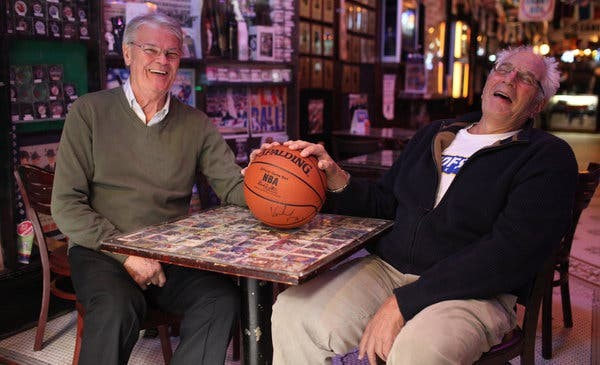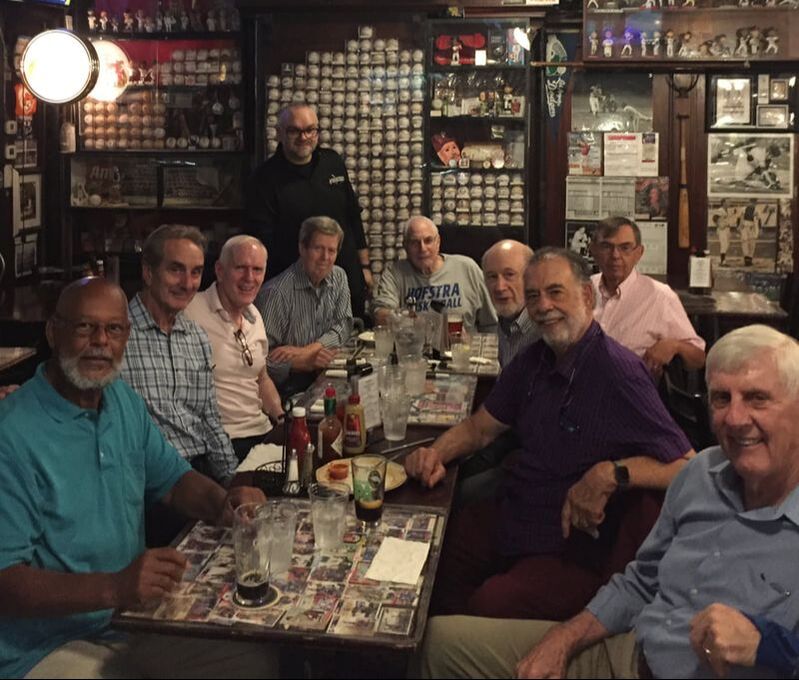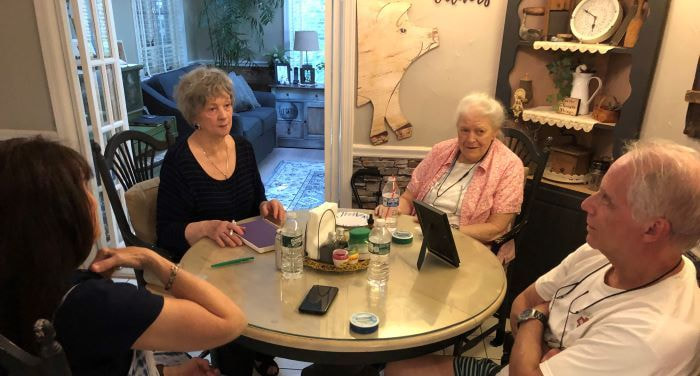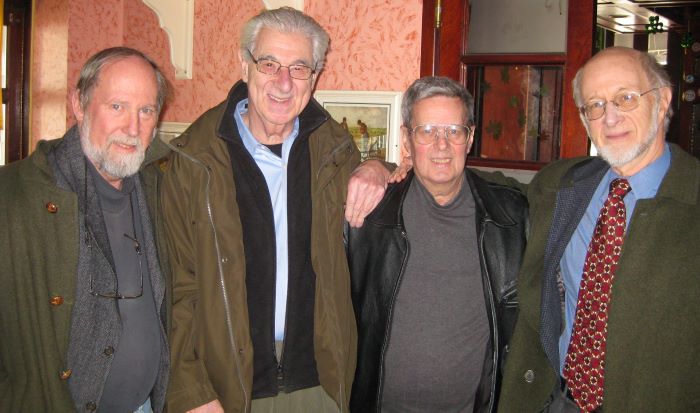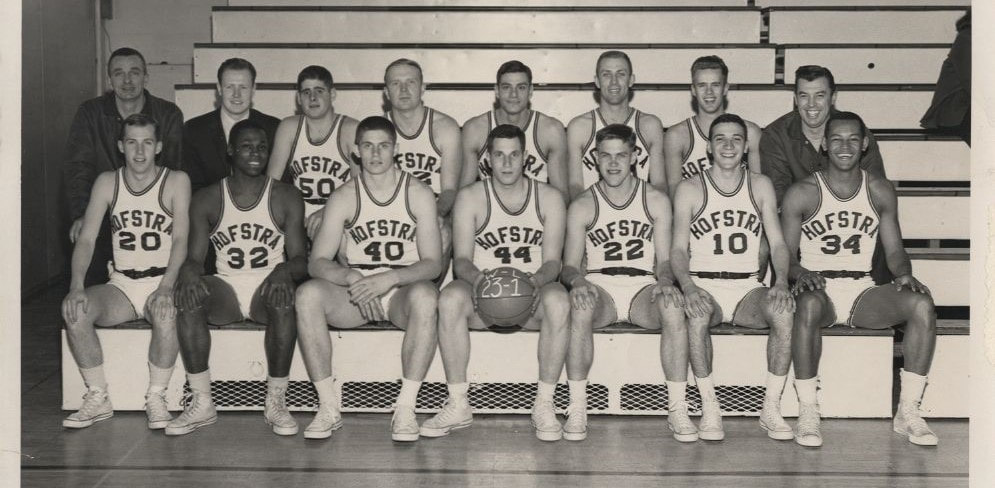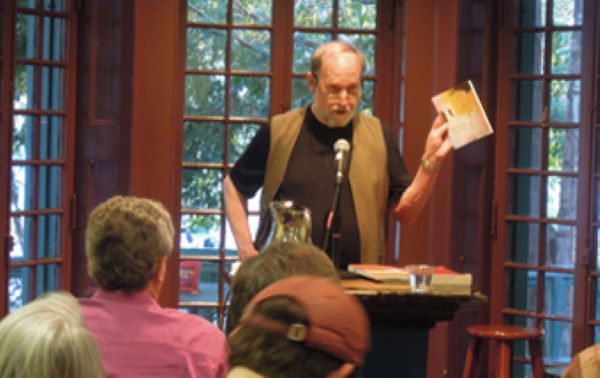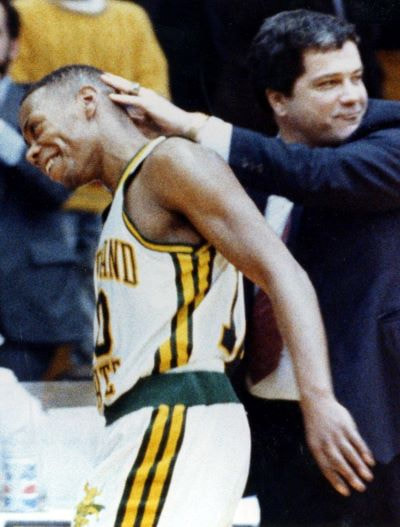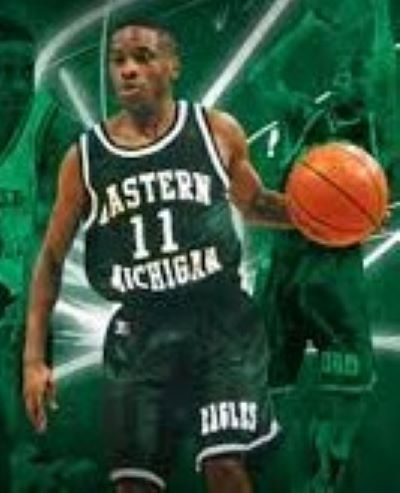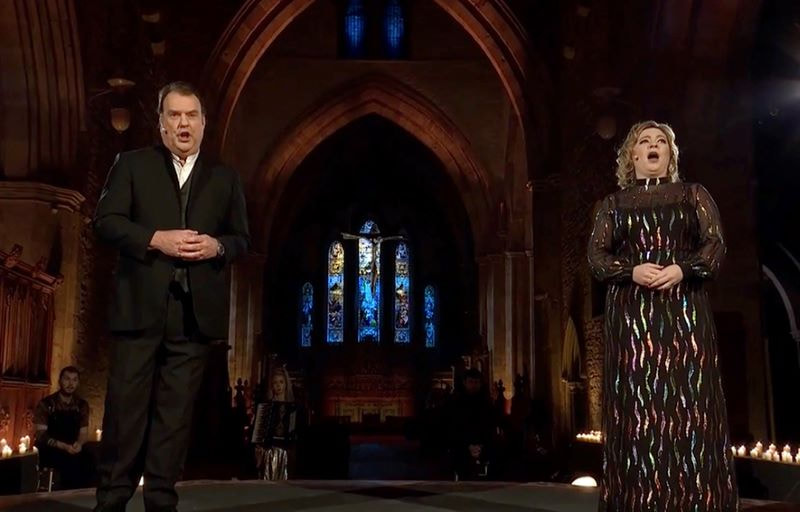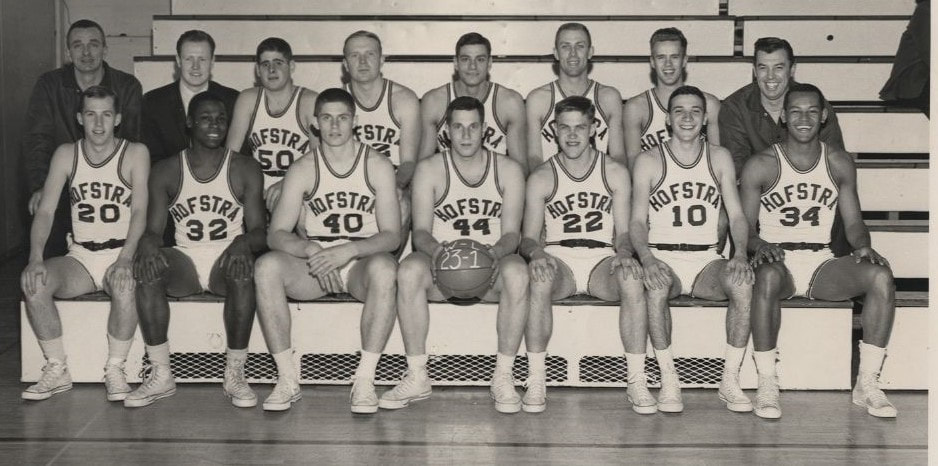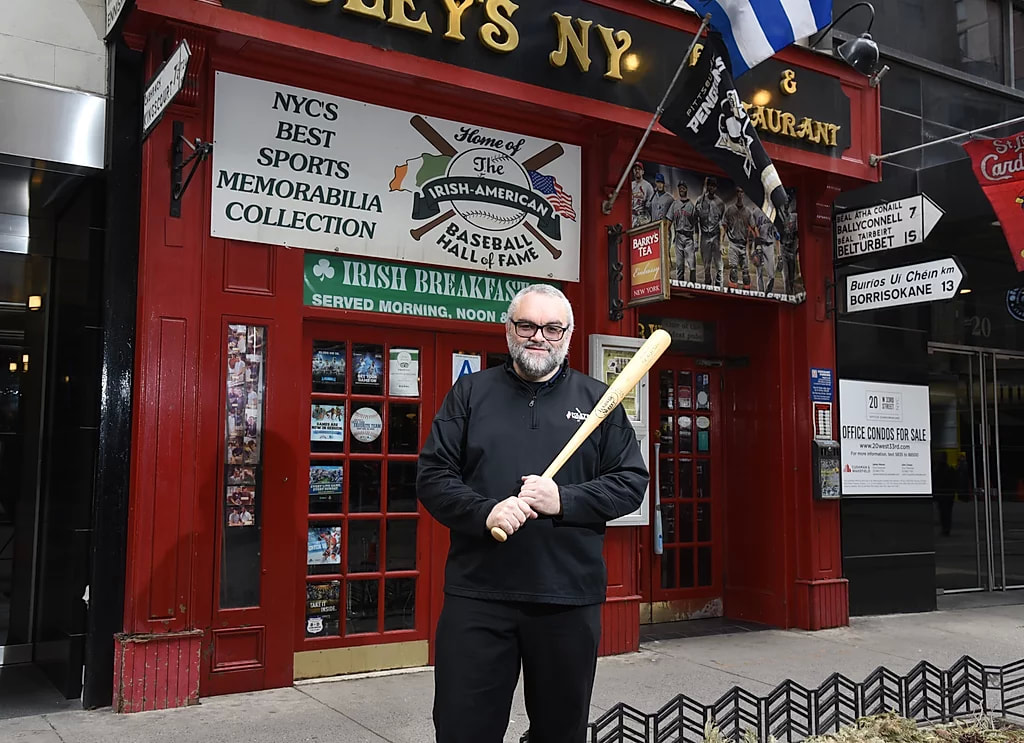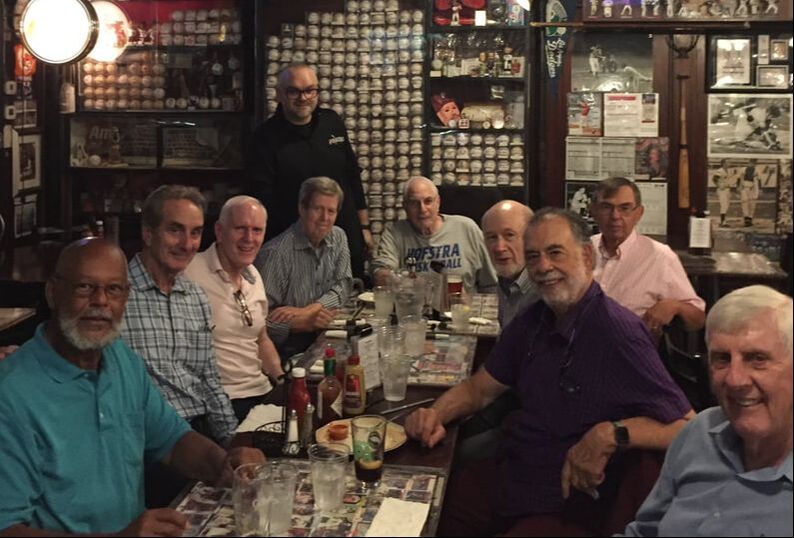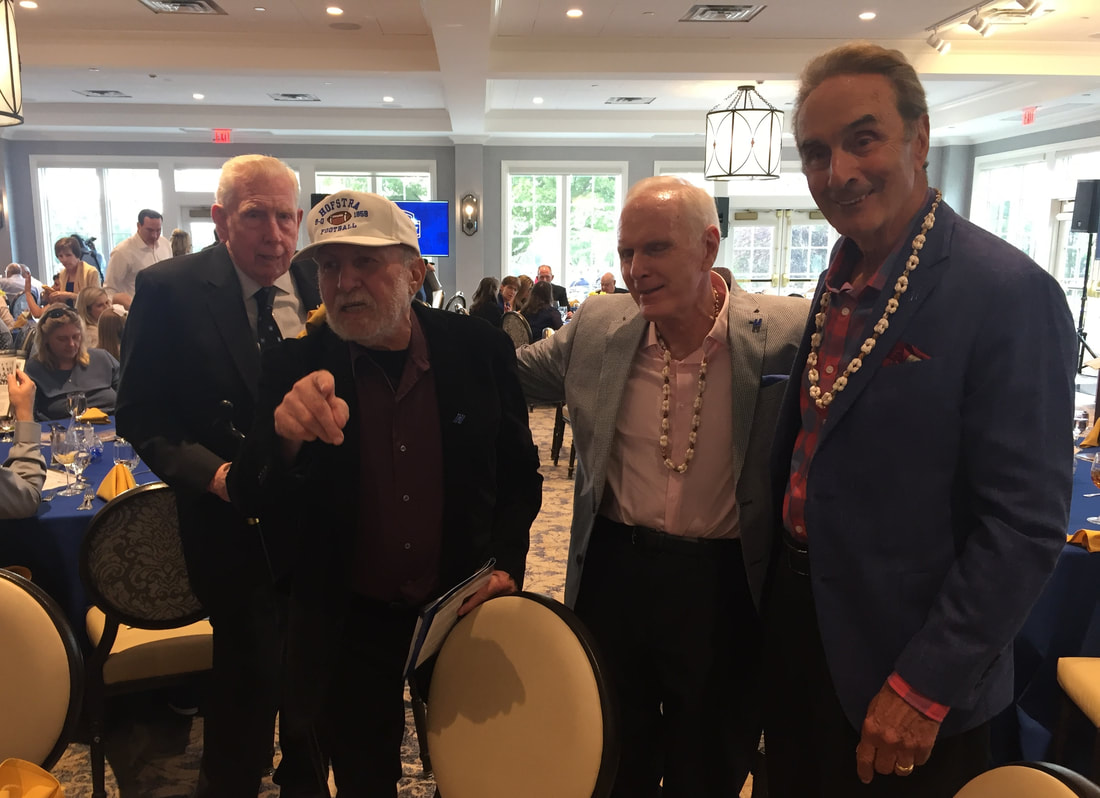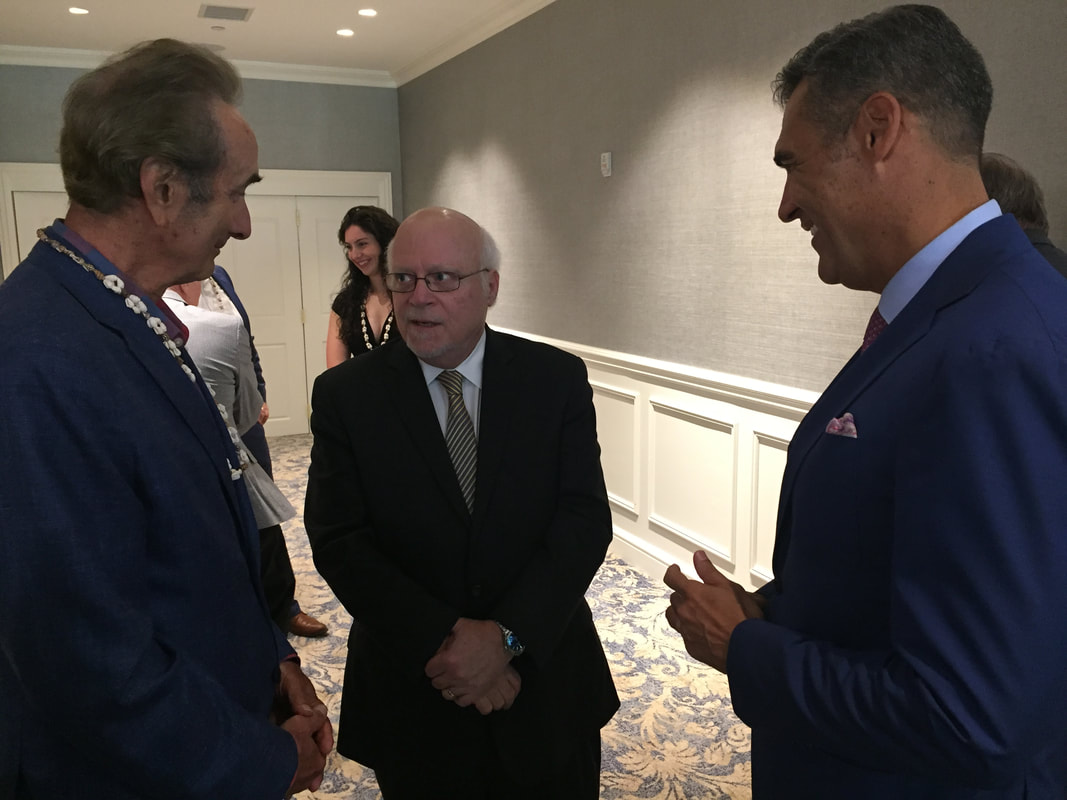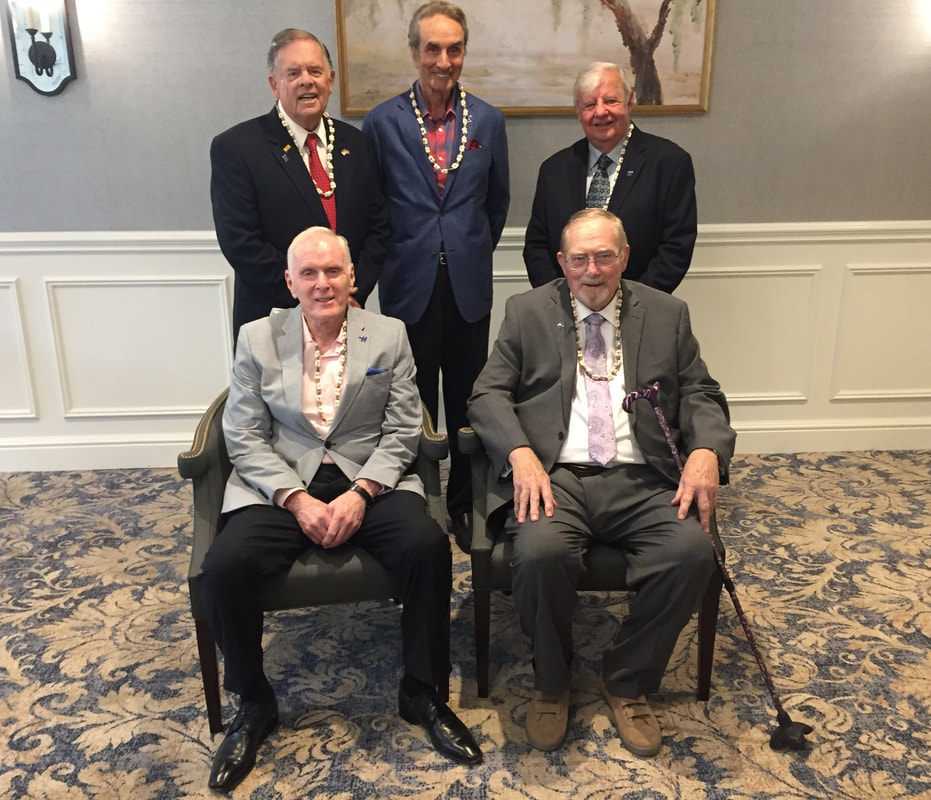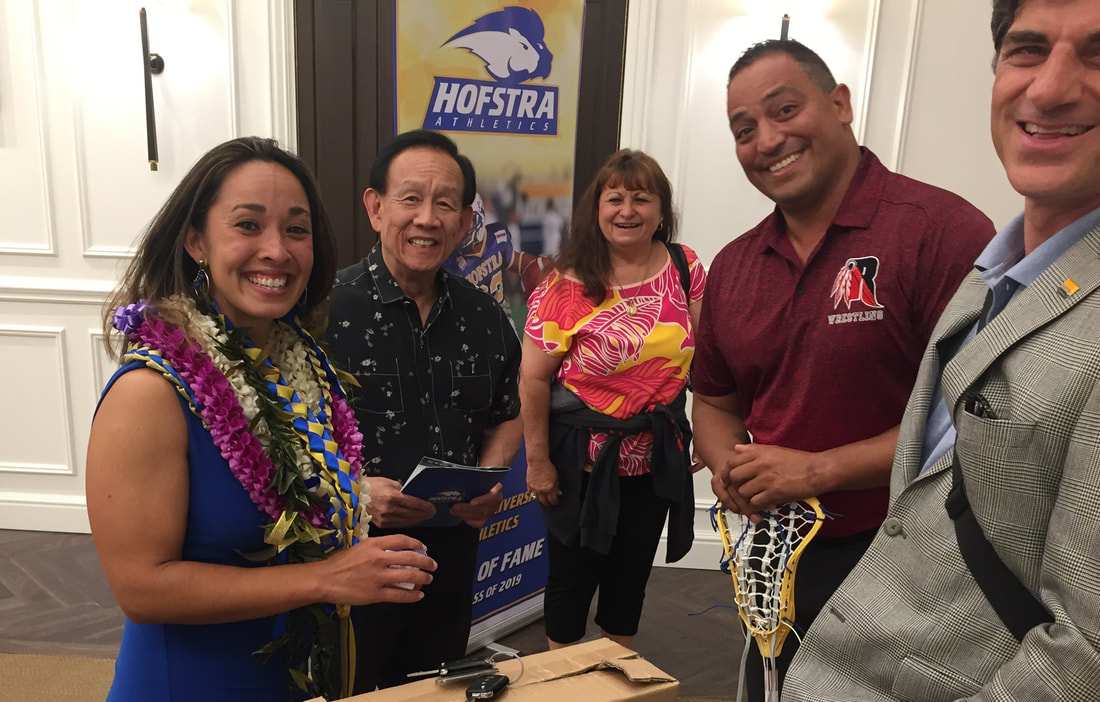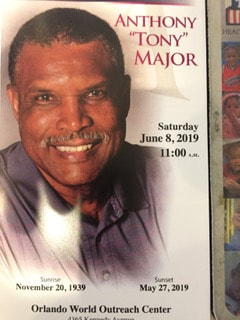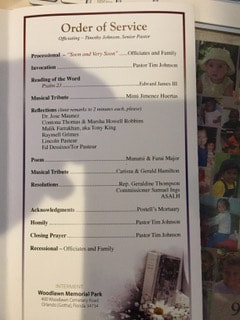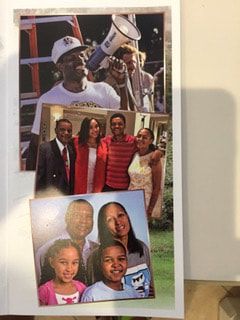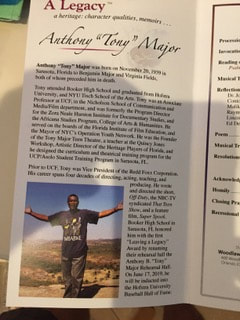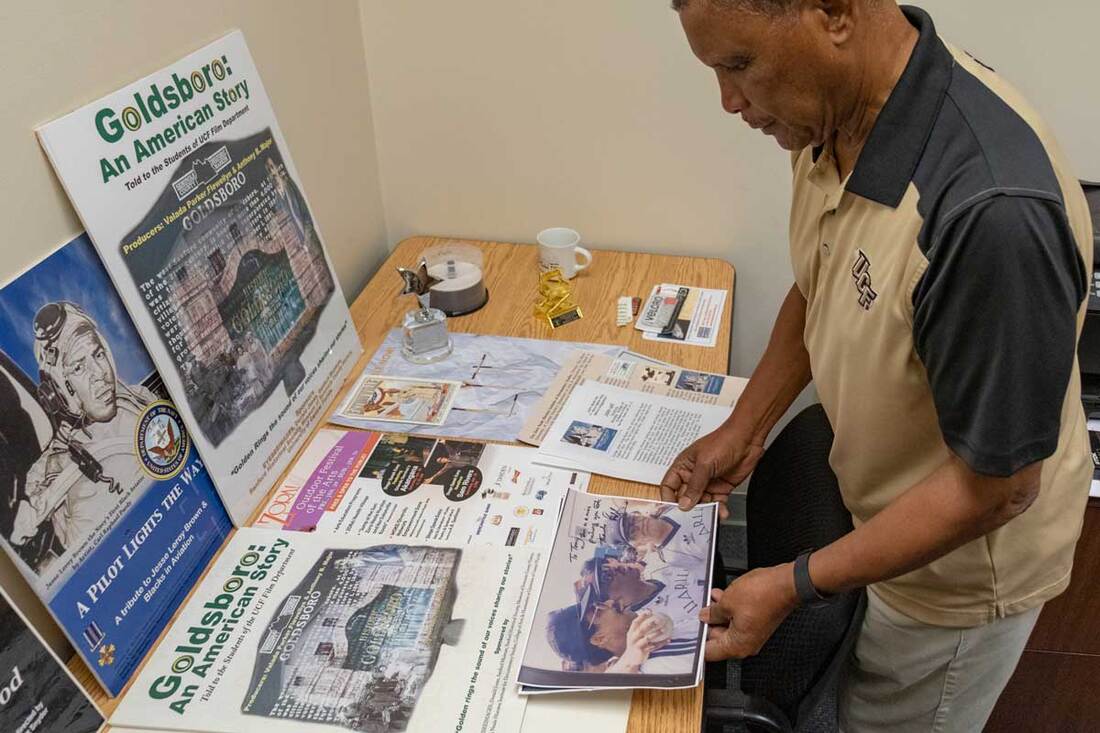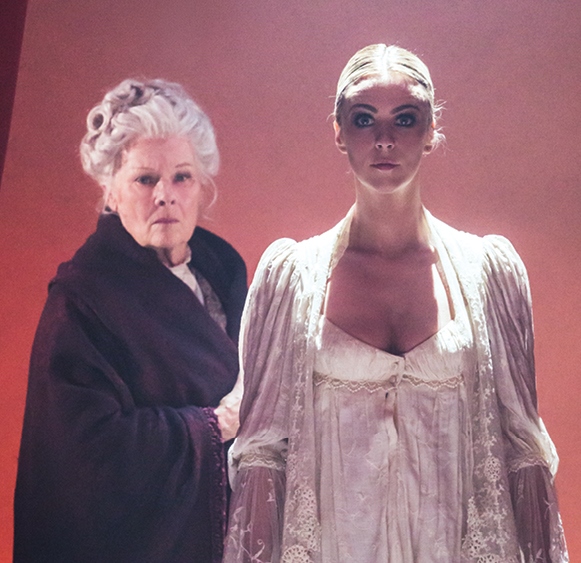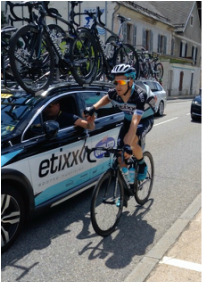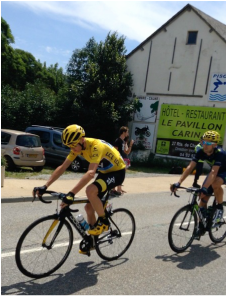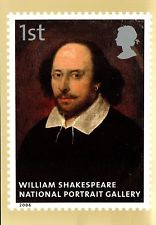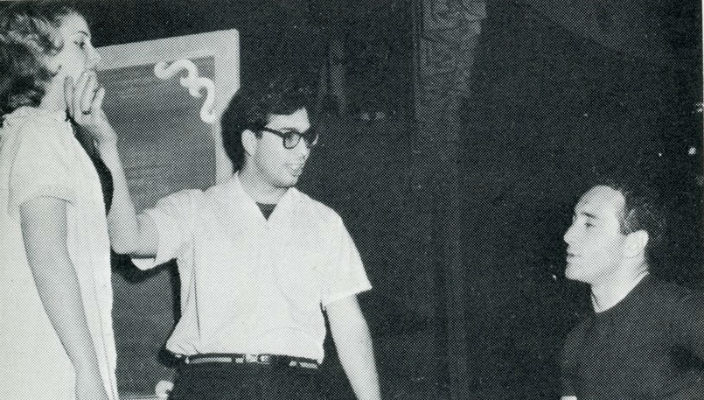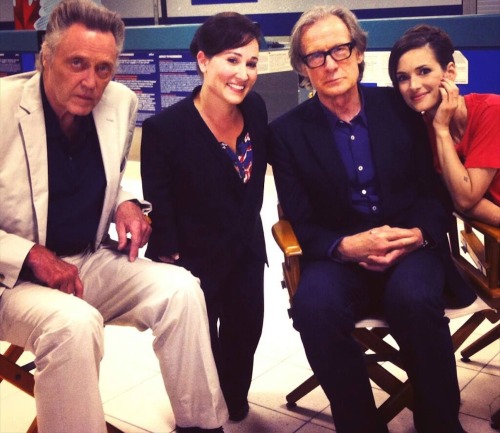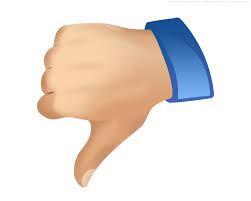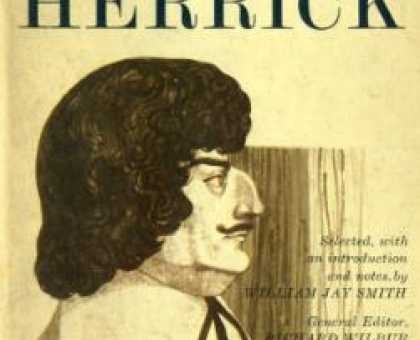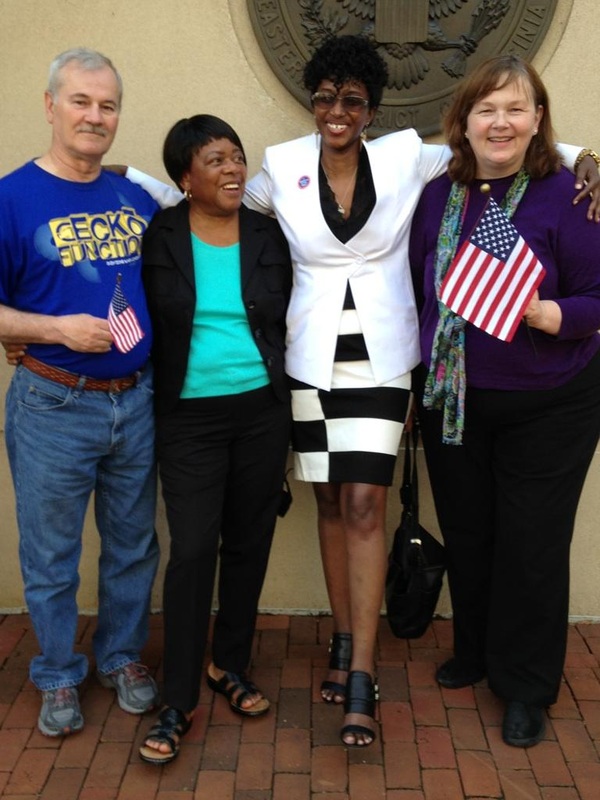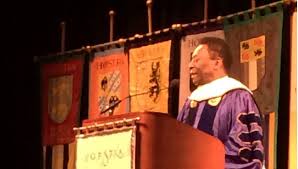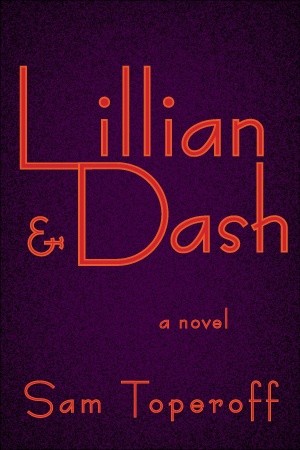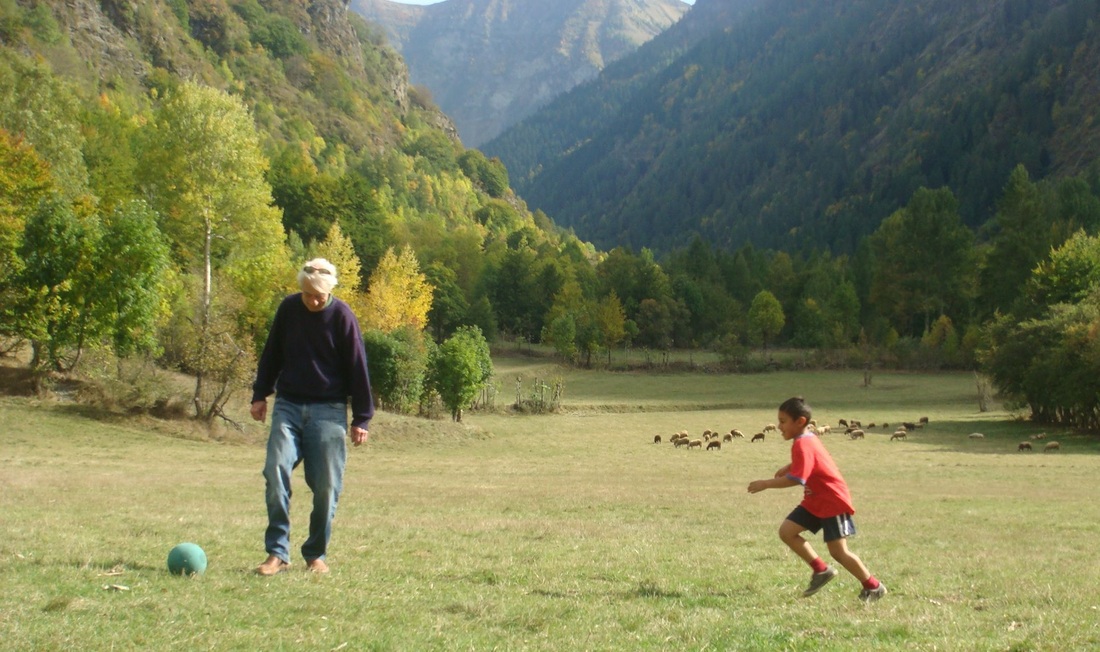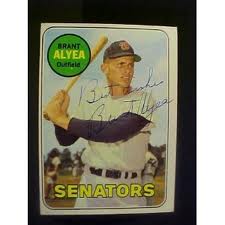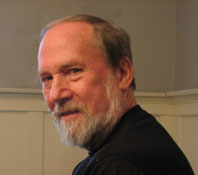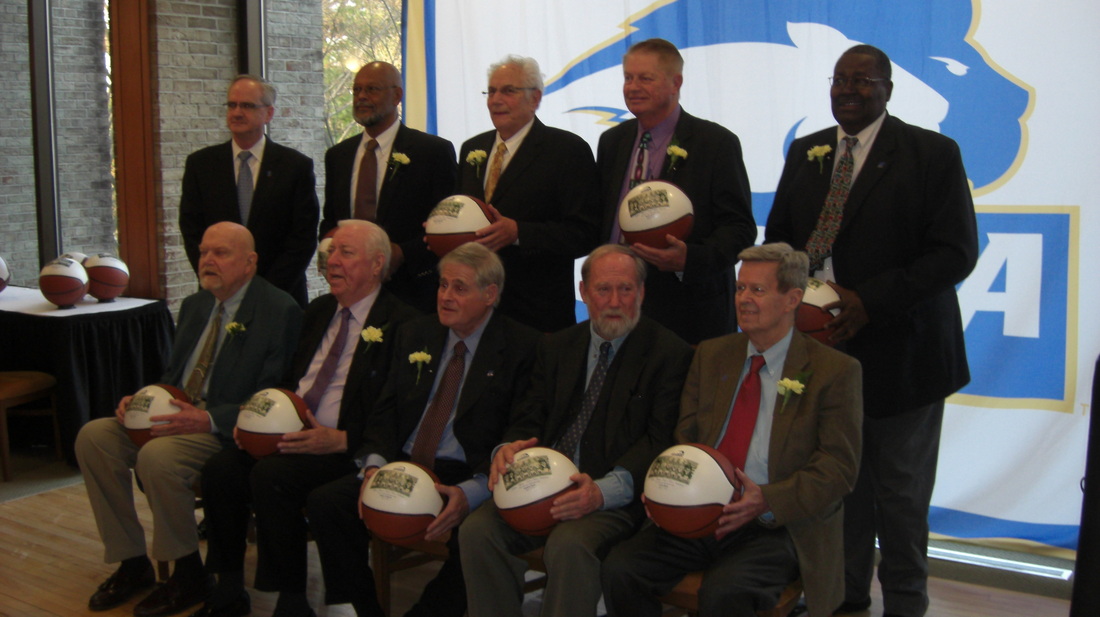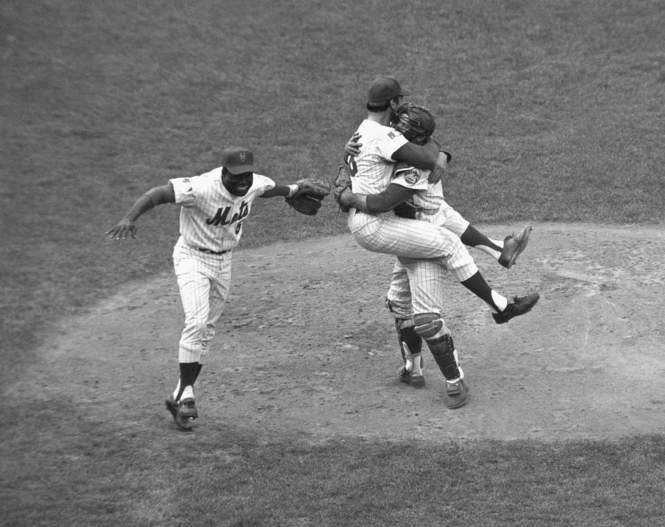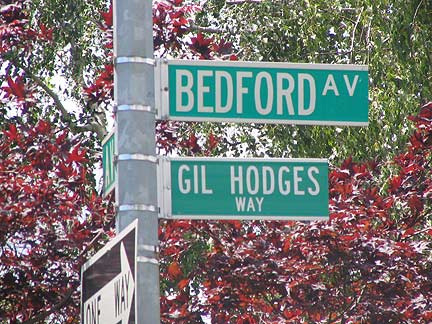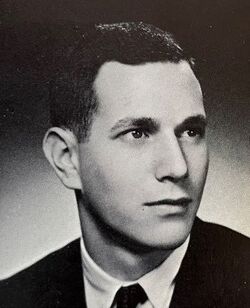 Stan Einbender, 1960 Hofstra yearbook. Carol Studios. Stan Einbender, 1960 Hofstra yearbook. Carol Studios. Stan Einbender, Jamaica ’56 and Hofstra ’60, passed on June 10. He had turned 83 on June 1, and had been in failing health for months, lovingly cared for by his wife, Roberta. This is a hard one for me to put together because Stan and I were in the same school for nine straight years -- Halsey Junior High and Jamaica High in Queens, then Hofstra College in Hempstead. Then Stan went to dental school and served as a dentist as a captain in the Army at Fort Lewis, Wash., and settled into his practice in New Hyde Park, marrying Roberta Atkins, helping her with their two children, driving around to dog shows all over the place, in with their English Mastiffs -- a big guy showcasing his big pets. We became much closer in the past two decades, as old Hofstra basketball and baseball guys (and one aging student publicist) got together at Foley’s in NYC. I would drive into the city and back, sometimes with other front-liners, Donald Laux and Ted Jackson. Basketball was our common denominator. Stan had a great souvenir of his season as a 16-year-old senior on the Jamaica varsity -- a scar on his forehead, from the city tournament in the old Madison Square Garden when he was hammered by Tommy Davis of Boys High. When Tommy became a star with the LA Dodgers, I would remind him that an endodontist on Long Island was looking to get him back. 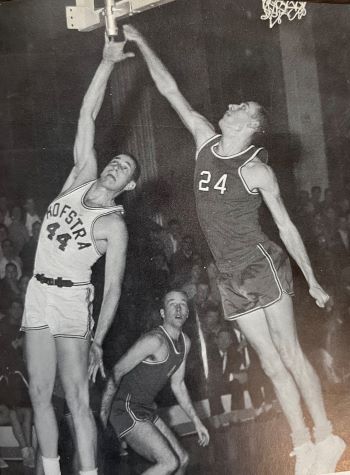 Stanley in 59-60 season. Stanley in 59-60 season. I was at courtside on a sleepy January afternoon in 1960 when Hofstra lost on a long basket by Wagner at the buzzer. It turned out to be the only loss in a wonderful season – 23-and-1, but not good enough to get into a post-season tournament. Half a century later, we caught up with the villain who had beaten Hofstra with that long jump shot – Bob Larsen and a couple of teammates met a few old Hofstra guys at Foley’s, and I wrote about that in the Times., https://www.nytimes.com/2012/03/01/sports/ncaabasketball/52-years-later-recalling-a-shot-that-sank-a-season.html In our old age, basketball was the link. Stanley had two season tickets at the Hofstra gym, right above the scorer’s table, and sometimes he would invite me. He became friendly with the coaches, first with Mo Cassara, then with Joe Mihalich, two basketball lifers who loved our old stories about the memorable coach, Butch van Breda Kolff, the old Knick. (Crude and also insightful, Butch was oddly formal, often calling his players by their full first names—Donald, Curtis, Stanley. As the publicist, I was “Grantland.”) Every October, Joe would invite us to a practice, let us sit behind the basket, give us frank insider critiques of his team. He called Stanley “Doc.” For one afternoon, my guys were part of the team, part of the school, again. I remember at one October practice, the star of the team, a shooting guard at 6-foot-3, also from Queens, was chatting with us, and was politely bemused that Stanley was the star rebounder at the same height. (I wrote about those sweet annual visits to our alma mater.) https://nationalsportsmedia.org/news/my-alma-mater-thrills-some-old-players- Just before the pandemic, Stan stopped getting around, because of Parkinson’s disease and other problems. We would talk on the phone and he would talk about Roberta’s art work and how well she took care of him…and proudly about their family: son, Harry, who had taken over the endodontist practice, (“better hands than me”) and his wife Macha and their children, Max and Remy, and Stan and Roberta's daughter, Margaret Morse, and her husband Richard and their children, Olivia and Henry. He always knew what they were doing. When I visited them last week, Roberta was masterfully managing a hospice operation. (I never heard him complain about his bad breaks with health, and he was always upbeat about the home care from aides like Kenia.) We sat by his hospital bed and we talked about the old days and our dwindling Hofstra guys, and his Yankees and his Rangers….and I praised how inclusive he was about his basketball world. This is what I told him: A decade ago, my wife and I were visiting our friends, Maury Mandel and Ina Selden up in the Berkshires, and Maury’s kid brother Joe and his wife Jean were also there. I suddenly blurted to the younger brother, ”Hey, I know you – from junior high school.” Turned out, Joe had been in the same class as Stanley – and had played on the same class team (Stanley was also on the school team.) I ostentatiously pulled out my cellphone and called Stanley: “I got Joe Mandel here, from Halsey.” They started chatting, more than six decades later, and Stanley told him, “You were a good point guard on our class team.” As any old schoolyard player knows, there is no higher compliment than being praised by a college star. Generous guy, Stanley. Then they started talking about the girls in their class. We continued that conversation the other day -- basketball and girls in our grade -- and for a few minutes, it was very nice to be 13 again. ** (It's so nice to see comments or emails to me, from old friends. Ken Iscol from junior high. Jean White Grenning and Wally Schwartz from Jamaica. A lot of the Foley's gang. Just to drop a few names. Roberta (I knew her brother, Jerry Atkins -- in grade school!) has held things together, admirably. The funeral is Monday at 11:30 AM at Beth David Cemetery, 300 Elmont Rd., Elmont, N.Y. 11003.) For the moment, please feel free to remember Stanley…and say hello to Roberta and the family… here…. They are monitoring the lovely comments here on this site. Thanks. GV Henry Aaron. Tommy Lasorda. Jim (Mudcat) Grant. Poring over the magnificent two-page spread in the Times, honoring prominent people who passed in 2021, I realized I could write reams about stars I knew from the locker rooms. I could also recall famous people I met here and there – Colin Powell, streetwise New Yorker ---- Vartan Gregorian, kind Armenian wise man -- and Larry Flynt, seedy champion of pornography, who happened to be a hilarious and incisive interview. But my heart, at year’s end, is remembering relatives and friends I got to know up close, who have left a personal gap. As Arthur Miller wrote: Attention must be paid. Aunt Lila. She was my wife’s aunt – helped raise her -- but she also became my aunt, jolly and chubby with a beautiful smile and a generous hug, over the decades, sidling up to me and asking about our children, our work (she had an admirable curiosity), and whether I knew the Lord. Her children and grandchildren cared for her in old age, shuttling her from northeast Connecticut to suburban Long Island, keeping her going, medically and socially. At a reunion last summer at a daughter’s home, Aunt Lila was wan, low on energy, and Marianne sat by her all afternoon, sensing this might be the last time, which it turned out to be. But Aunt Lila’s smiles and hugs and kind acceptance linger on. Captain Curt. Once a point guard on very good basketball teams at Hofstra, Curt Block became a publicist at NBC and had other memorable gigs. (As a young reporter, he interviewed young Cassius Clay, and had the presence of mind to keep the rudimentary tape, re-discovering it in old age.) When aging baseball and basketball players (and one scribe, me) began to meet periodically at Shaun Clancy’s great place, Foley’s, Curt took the slow train up from Philadelphia and became the greeter, the treasurer, the captain, sitting in the middle, enjoying everybody else’s stories, moving the ball around, as he had against Hofstra’s opponents, back in the day. He quietly alluded to impending heart surgery, and last summer he went to sleep and did not get up. Because of the pandemic, the old boys have not been able to meet since, to uniformly mourn our quiet leader. Neighbor and Nurse. Ann Schroeder was a nurse in the Bath-Brunswick area of Maine. She got to know my wife’s Uncle Harold (older brother of Aunt Lila) and she became a volunteer guide to his old-age miseries. We got to know her through her detailed emails, explaining Harold’s health problems, what was being done, so we could assure his relatives that he was surrounded by skilled, loving friends in that wonderful area that has become our own sentimental home. After Harold passed, we stayed in touch – via health newsletters Ann sent. She casually alluded to her own breathing issues, and last summer she noted that she was now on hospice, and then the e-mails stopped. In keeping with this understated woman, her service was private.
Mentor to Surly Luddites. Howard Angione was a reporter who somehow wandered into the emerging technology age at The New York Times, in the mid-1970s. With the reserved air of a theologian, he had to introduce temperamental reporters to the bulky Harris terminals now placed around the City Room. Sometimes these terminals would swallow articles whole, provoking profane tantrums from cranky news reporters like, well, like me. Howard’s motto was: “If I can teach Vecsey, I can teach anybody.” Which he could. After his missionary work in the City Room, Howard went to law school and specialized in elder law, until he became an elder himself. The NYT did not note the passing of the tutor who helped modernize the paper, but the Portland (Maine) Press-Herald did. Zone-Buster Poet. Stephen Dunn was a rather shy jump shooter who could beat down a zone defense. On one road trip, he heard two older Hofstra teammates discussing a novel, and he realized jocks could also be scholars – and later he began to write poetry, ultimately gaining a Pulitzer Prize. His later years were spent fighting Parkinson’s disease, which got so bad that he could not recite his own work. Our friend, once known as “Radar,” was deservedly included in the NYT’s gallery of notables in Friday’s year-end necrology. My Cousin Artie. From my earliest memories, I admired Art Spencer, my oldest cousin. He was so cool – riding a two-wheeler, driving a car one summer in rural Pennsylvania, with friends who had musty, mysterious barns amid lush corn fields, going to college, going into the military, marrying, starting a family. At family gatherings – some joyous, some sad – I had to practically pry out of him that he and Shirley had a flourishing crafts business, designing house signs – staples at weekend crafts exhibits near Ocala, Fla. The women in his family cared for him lovingly in his final months, and then staged – sign of the times – a Zoom service to honor an understated and artistic life. Agent and Friend. Philip Spitzer was my agent who negotiated a durable contract with a publisher and the manager of Loretta Lynn – a project in 1974 that turned out to be the book and the movie, “Coal Miner’s Daughter.” I can still see Philip -- suave, part French, athletic, sitting on Berney Geis’s rooftop patio in Manhattan, holding his own, word by word, paragraph by paragraph, with two legalistic sharpshooters. We became family friends, his three children, my three children, good memories, even if the guy would never, ever, let me win a tennis set or a basketball game. Even after we did not work together, we stayed in touch, and as his health deteriorated, he passed the Loretta project to his capable oldest child, Anne-Lise Spitzer. This magnificent seven stands in for all the people in my life who passed in 2021. As far as I know, Covid did not figure in any of their passing – just the inevitable erosion of time, long and good lives, now ended. Our best wishes to all who read this tribute. As one often hears in corners of New York: Be Well. Long before he won the Pulitzer Prize, Stephen Dunn helped win basketball games.
His soft jump shots from the outside floated into the basket, often enough to earn him the locker-room nickname, “Radar.” His game was soft, gentle. His poetry had the impact of a subtle elbow, making its point. He found himself along the road from the Queens playground to the Hofstra College gym to the gatherings where he read his poems. We watched him soar, higher in poetry than he ever did in basketball, but always one of us, a bunch of Hofstra jocks – student-athletes, actually – plus, one former student publicist who became a journalist. The quiet bloke at our table at Foley’s, the great sports pub, was a big-timer, with the 2001 Pulitzer to prove it, not that he ever brought it up. Radar was always quiet, modest, observant, and accurate. The last time I talked to him, months ago, he allowed as how he was now confined to a wheelchair from Parkinson’s Disease, and his voice was so badly shot that a good friend would have to read his latest work at some Zoom poetry gathering. Then it got worse, and Stephen Dunn died Thursday on his 82nd birthday. Stephen was another advertisement for the Hofstra of the late ‘50s – when Hofstra was stretching from a suburban commuter college, making a pitch for city kids – Francis Coppola from Queens, Lainie Kazan from Brooklyn, Tony Major from Florida and Harlem, and Stephen Dunn from Forest Hills, Queens. Stephen won a starting job as a sophomore, was the second highest scorer, but always quietly, hesitant to roar. He was a first-generation college kid, and did not know how it all worked. But on one of our big-time road trips all the way to Allentown or Gettysburg, he was listening to two older teammates, Sam Toperoff and Dick Pulaski, talking about "Moby-Dick," talking with enthusiasm and insight and opinions. Wow, Radar thought. He began to pay more attention in class, began to work at his writing. That was one epiphany. The other epiphany was next season, matching up with a new player on the team, from a basketball family. “He could block my jump shot. He could steal the ball from me,” Stephen wrote in an essay, “Basketball and Poetry: The Two Richies.” (This lovely essay is in “Walking Light; Essays and Memoirs,” W.W. Norton and Co., 1993.) “No one could free me from Richie Swartz. Richie Swartz turned me inward to where doubts are, and doubts, while good for the poet, are bad for the athlete.” (The “good Richie” was another teammate, Richie Goldstein, who once fed Stephen for 45 points in a Press League game.) When Stephen Dunn was a celebrated poet, he would often read from this essay, and when he was finished lauding Richie Swartz, Stephen would add: “You son of a bitch,” but lovingly. Stephen was still a core player on the 1959-60 team that won 23 games and lost 1, and crushingly was not invited to any post-season tournament. Stephen surprised himself by playing a season in the Eastern League, crowding into a car with more celebrated former college players, for weekends in Williamsport and Sunbury, Scranton and Camden. He was a pro. Then circuitously, he became a poet. Dunn’s life and career are best appreciated in the obituary by Neil Genzlinger, in The New York Times: https://www.nytimes.com/2021/06/25/books/stephen-dunn-poet-dead.html Stephen Dunn lived his final decades in an aerie outside Frostburg, Md., with his wife, Barbara Hurd, also a writer, specializing in nature. They held occasional soirees, with friends from around the region, people who liked to write and read and listen and talk. And his legs gave out, and his voice gave out, and on Thursday, all of him gave out. Happy Birthday, Radar. You can get off your feet, your jumper arching perfectly, into the basket. This was always one of my favorite weeks, when I was working – the first round of the NCAA men’s tournament, when weird things could happen, and did.
I loved being in some arena, with eight – count ‘em, eight – teams still alive, still dreaming. Teams I never heard of during the long season, teams with fresh nicknames and gaudy colors and wired coaches and peppy cheerleaders and sassy mascots. Sometimes we were seated near the college bands, with their own characters and sizes and shapes and hair styles. Sometimes they were more fun to watch than the game. I have other events I love – any match in the World Cup of soccer, the U.S, Open of tennis in my home county, and just about any Mets game, because. Oops, almost forgot epic Stanley Cup finals of Islanders or Rangers, plus The Derby in Louisville, where we used to live. I remember my pal Charlie Pierce always loved the Saturday of the Final Four, but I hold out for the opening day, for the unknowns, the upsets, the slippery slopes. Take the first round in 1986. I was there, Perpetual contender Indiana was playing outsider Cleveland State. Before the game, Bobby Knight swaggered out to shake hands with his counterpart, Kevin Mackey, chubby little dude out of Boston. Some words were spoken, followed by cranky words and gestures from the terrible-tempered Knight. ''I said, 'Hey, take it easy on me, Big Guy,''' Mackey told reporters later. ''But, hey, he's no fool. I'll paraphrase his answer for you. He said: 'I'm not gonna give you any breaks out there.' '' I’ll bet he paraphrased Bobby Knight. Then, Cleveland State, seeded 14th in the region, promptly beat Indiana, seeded third, 83-79, and Knight, who liked to lecture reporters, said any fool knew that Cleveland State was loaded, with a guard named Mouse McFadden, New York City guy, who had somehow wound up at Cleveland State with an outlaw/outsider tag. I have to tell you, it was fun. And the fun continued to the next day when Cleveland State showed up early for its off-day media conference and witnessed the players from Navy – particularly David Robinson, close to his ultimate 7-foot-1 height, in spit-shine shoes and uniform and polysyllabic vocabulary and braces. Mouse and his mates were clearly impressed by Robinson's polished interview. Ten years later, double upsets on the first day: defending champion UCLA sleepwalked against Princeton, which cut them up with crisp interior passing, and I re-named the school “The University of Catatonia at Los Angeles.” The same first round, tiny Earl Boykins, looking like somebody’s sixth-grade kid brother, helped Eastern Michigan stun haughty Duke, 75-60. In the closing minutes, Boykins dawdled with the ball, staring into the stands while dribbling. It was his night. In the next round, little Boykins (admitting he might not even be his listed 5-foot-7) was beaten by Connecticut, whose coach, Jim Calhoun, raved that Eastern Michigan reminded him of his first coaching stop, with Northeastern in Boston -- outsiders, bootstrappers, who never gave up. You didn’t have to be at the game. In 1991, I turned on the television and watched Richmond, seeded 15th, coached by Dick Tarrant, city guy out of Fordham, play a brainy, resolute game to knock off Syracuse, 73-69 – the first time a 15th seed had defeated a second seed. The last barrier fell in 2018 when the University of Maryland, Baltimore County, defeated Virginia, 74-54. For a list of major upsets, see this. Last year, there were no upsets, no nothing. My alma mater, Hofstra, reached the finals of its conference tournament against Northeastern and Coach Joe Mihalich called a timeout and delivered an impassioned speech about playing the best five minutes of their lives – which they did, with baskets and stops and rebounds, and celebrated the victory for the next 24 hours….until the NCAA called off the tournament because some people in the country had figured out there was a pandemic going on. I later told Mihalich – a lifer, who made some of my old jock friends feel welcome -- that this was a great five minutes of coaching that he would always remember. Now Mihalich has missed this season for health reasons, and Hofstra fell short. Joe, you know what my Brooklyn Dodger fans used to say: “Wait til next year.” I pay almost no attention to college sports these days, but I have memories. At this time of year, when fellow Irish-Americans celebrate, I know it’s time for the NCAAs. This year’s entire tournament is being held in Indianapolis, a traditional center of basketball in this country. The players will keep the game going until the world gets back to some semblance of normal, when we can pay more attention to stomping coaches and high-flying players and acrobatic cheerleaders and crowded stands – and wide-eyed student lunatics in the pep band blaring saxophones. Plus, upset time. * * * My 1986 column on Cleveland State: https://www.nytimes.com/1986/03/16/sports/sports-of-the-times-the-secret-is-out.html My followup column on Mouse McFadden and how he got to Cleveland State: https://www.nytimes.com/1986/03/19/sports/sports-of-the-times-the-mouse-makes-the-grade.html My 1996 column on Earl Boykins: https://www.nytimes.com/1996/03/15/sports/sports-of-the-times-earl-boykins-has-arrived-on-the-scene.html When Indiana gave its heart to underdogs Princeton and Eastern Michigan. https://www.nytimes.com/1996/03/17/sports/sports-of-the-times-indiana-gives-its-heart-to-game-s-underdogs.html There are people out there, breathing a killer virus at you. There is also a ton of snow on the ground where I live. My suggestion: try tuning out the Lame-Duck Orange Sicko for a day. I did it over the weekend. Good Stuff on everywhere. . I started with a link from a friend known as The Cork Lady. (Ireland, that is.) She and her husband sent me a link to a concert via the shut-down Metropolitan Opera -- Bryn Terfel with a holiday concert from his native Wales. What a wonderful surprise: the concert (with no audience) was in the Brecon Cathedral – a place we know and love, in the highlands above Cardiff, The vivid stained-glass brought back memories of a beautiful summer evening, still light outside, our friend and host Alastair (like all Welsh men) singing in a chorus. While Terfel and a talented cast took turns, my mind drifted to Brecon in long-ago summers --sheep being marshalled by border collies, the jolly sound of tourists on canal boats from the nearby Usk River, trips to upscale pubs along the canal, and Alastair going to Brecon market to buy lava bread (pungent, allegedly edible seaweed from the coast.) Not exactly Christmas memories, but lovely memories nonetheless. At 5 PM, another link – this one via the Pulitzer-Prize winning poet, Stephen Dunn, my friend from his days as a zone-busting shooter for Hofstra College. No. 20 was known as Radar on a 23-1 team. Radar writes as he shot – smoothly -- his latest book, Pagan Virtues, just out. Stephen’s poetic aim is still perfect but his voice does not permit him to read his own work these days. In a weekly web poetry reading, called LitBalm, some of his new work was read, and read well, by his friend Indran, while Stephen listened in one of the squares on the laptop grid. Keep lofting these jumpers, man. 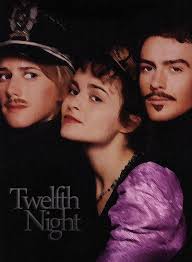 They figure it out They figure it out At 9 PM, we turned on the local PBS station, Channel 13, with its Saturday-night feature -- a classic, or classy, movie (sometimes, inexplicably, displaced by drippy oldie concerts). But not Saturday. Mercifully, there was the Trevor Nunn movie version of “Twelfth Night,” from 1996, Shakespeare’s gender-bender comedy, with a cinematic shipwreck and looming Cornwall hills and castles and Helen Bonham Carter falling in love with a saucy emissary with a highly dubious mustache draped across her kissable upper lip. The cast, as in any English rendition of Shakespeare, was marvelous, but let me praise two: Nigel Hathaway as Malvolio, the resident mansion bully, and Ben Kingsley, for goodness’ sakes, as an omnipresent troubadour (with a really nice voice, his own; it turns out that Kingsley was once urged to pursue singing by his pal, John Lennon.) (We recently saw a stage version of Twelfth Night via the marvelous National Theatre's at-home series, prompted by the pandemic. In that version, Malvolio is female, played by Tamsin Greig, and her comeuppance seems more cruel than Hawthorne’s.) During the final scene Saturday night, when everybody finally figured everything out, I had tears in my eyes. Good Shakespeare does that to me. The antidote for tears came nine – count ‘em, nine – minutes later, on “Saturday Night Live,” the last new one for a month apparently. The host was Kristen Wiig, one of the all-timers, visiting her old haunts. Her opening bit was singing the wintry standard “My Favorite Things,” and when she botched the lyrics, she was joined by another all-timer, Maya Rudolph, who also botched the lyrics, and was in turn joined by the current all-timer Kate McKinnon. Regarding McKinnon: I am watching SNL more in my “retirement” than I ever did, and am totally enthralled with McKinnon In the all-time web ratings of SNL females, I propose St. Gilda as first, and Tina Fey as second (those laser eyes, looking right at you), and McKinnon now ranks third, with me. I love her versions of Rudy and Dr. Fauci and that fuzzy little attorney general, Jeff Sessions, and McKinnon also aces some dark-side female roles, throwing off heat in all directions. How Shakespearean. 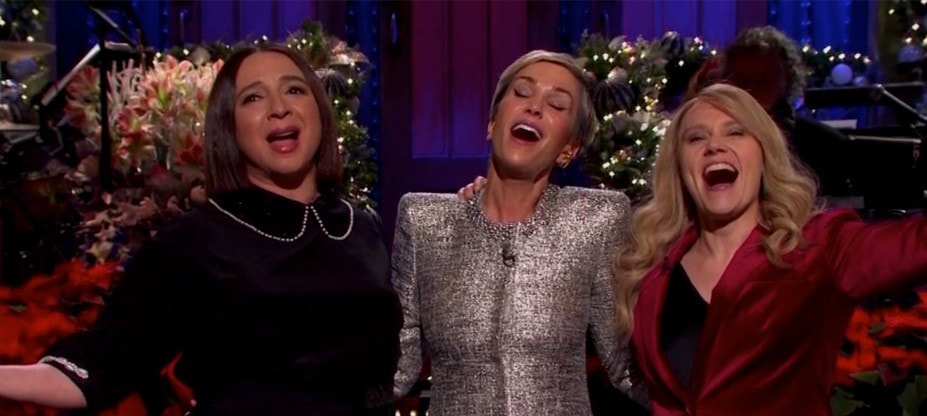 That brings us to Sunday. The far-flung family of Anna and the late Kate McGarrigle is staging a virtual reunion, Sunday, all over the world, apparently. It will be streaming (at a price) and available for two weeks, starting at 3 PM. The cast includes longtime backup Chaim Tannenbaum, third-sister Jane McGarrigle, and other staples of that wonderful time. I will catch it, and think of Kate. * * * Also, Nick and Teresa Troiano Masi (Terry and I worked on the paper at Jamaica High) have a grown daughter, Terri Dierkes, who is a cantor in a church in Connecticut, and a leading member of a lovely Christmas concert, which aired Sunday. Details at: https://www.musae.me/terridierkes/experiences/876/an-enchanted Finally, ongoing, for a season of great plays in our homes, the National Theatre is showing 12 filmed plays, for quite modest fees. We've seen about half in recent years. Wonderful stuff. https://www.ntathome.com/products?webSyncID=15a5de53-1723-d49e-1058-0eb4b6cd67b0&sessionGUID=2739e281-ec60-d680-c4d7-0b68a7328c91 * * * There’s a pandemic out there. Nasty weather all over. Stay safe til the vaccines get here. You can't watch The Dangerous Fool every second. Ride it out. Stay safe. Happy Holidays to all. Tuesday, June 2: Finally: I answered the first 13 Comments. I've been corresponding with two Bay Area pals about favorite locals. Best. GV.
(The following was written Friday afternoon. It may seem trivial, given the virus, the malfeasance of Trump, and growing protests around the country, to write about a baseball-centric pub, but this also happened on Friday, leading to this response from me and others. Be safe. GV.) The world will never be the same. We say that a lot these days, about death and loss of work and the blurring of the future; now something else has been wrenched away. Foley’s went down Friday, officially. It was a grand contradiction – Irish? Baseball Pub? – and for thousands upon thousands of regulars it was home. We all rubbed elbows, when business was good – baseball umpires and out-of-towners and business types and guys at the bar who seemed to have a lot of free time in mid-day and, when a big game was on, clusters of loyal fans who claimed it as their place. It could have been a funky little pub off in the Irish countryside, particularly when Proprietor Shaun Clancy and his father John Clancy were in attendance, with their lush accents. No matter what time of day it was, John Clancy was always eating an Irish breakfast. Foley’s was Shaun’s baby. He learned baseball in the States while his dad worked at Toots Shor’s, the Foley’s of its day, particularly when DiMaggio or Sinatra was in the place. At Foley’s, it was more about Joe McEwing, a Mets supersub, taking a kid named David Wright out for a late supper on his first time in the majors, and now there is a David Wright sandwich on the menu. Baseball was on the walls, and on the ceilings – all manner of memorabilia, thousands of autographed balls. Our group of old Hofstra jocks (and me, scribe-for-life) has been meeting there for a decade; the first time Brant Alyea, who played five years in the majors, joined us, he had to sign a ball for Shaun. The place faces the Empire State Building on 33rd St, just west of Fifth. There are Irish road signs out front in case you are lost. The bar is on the right of a narrow corridor down the middle, and on the left is a men’s room with three enormous enamel urinals taken from either the old Waldorf or the old Astoria when the two hotels merged uptown. Now I am wondering: who gets the urinals when the landlord goes back to Square 1? Shaun named the place for Red Foley, the leprechaun of a sports wizard who graced the New York Daily News when it was America’s most powerful newspaper. Red knew everything. His column was called Ask Red. https://www.nydailynews.com/sports/baseball/red-foley-remembered-work-decency-character-article-1.350837 Mostly you heard Irish accents from the manager and the bartenders and the waitresses, but the staff also had a New York mix including Kathy-the-Waitress who I think hailed from Brooklyn. Every time we Hofstra guys gathered, Curtis-the-Point-Guard would order shepherd’s pie and Kathy-the-Waitress would squawk, “You can’t order that! It’s not healthy for you!” Shaun Clancy made everybody feel welcome. He would stand with us and whisper inside stuff he had heard. Our star baseball players like Jerry Rosenthal the shortstop and Dennis D’Oca the lefty, both from Brooklyn, glowed when Shaun dropped inside stuff on us. Like regulars in any pub, we brought guests. One time our Hofstra contemporary, Francis Ford Coppola, joined us, and listened to our opinions and our questions about his movies, just one of the guys, more than half a century later. One time we entertained a few hotshots from Wagner who had ruined an undefeated season for Stanley and Ted and Curtis and Stephen Dunn, the zone-busting guard, now a Pulitzer Prize poet. In recent years, we saw less of Shaun because he had (a) a place in Florida and (b) a lady friend, Kristie Ackert, baseball writer with the Daily News. They seem so compatible that they must have been introduced by the great matchmaker in the sky. When the virus hit in late winter, Shaun shut it down and took off to Florida -- paying his staff for the duration. This week he took a look at the books and realized the bleak future for drinking, eating and rooting in close proximity in high-rent midtown. Here is Shaun, Friday, on Twitter, grief all over him: https://twitter.com/FoleysNY/status/1266403932156370945?ref_src=twsrc%5Etfw%7Ctwcamp%5Etweetembed%7Ctwterm%5E12664 I am now in mourning. I cannot imagine the next time I will take a train or subway into the belly of the beast, and mingle in a clean, well-lighted place like Foley’s. Plus, this is my second heartbreak. For more than a decade, I was a regular in L’Angolo on Houston St. in the Village, an Italian soccer cafe. Con Ed construction and smoking restrictions and landlord gouging killed L’Angolo in 2008 but somehow I was granted another home place for the past decade. The way I see it, Shaun Clancy ran a place as memorable as Shor's was when his dad was working. Nothing lasts forever. Thank you, Shaun, for a great time. * * * But don't take my word for it. Pete Caldera, the singing writer, or writing singer, is a true Foley's regular. Here is his ode from USA Today: https://www.usatoday.com/story/sports/mlb/2020/05/29/foleys-nyc-new-york-baseball-bar-closing-down-16-years/5288724002/ More about Foley’s: https://www.foleysny.com/clancys-corner https://www.nydailynews.com/new-york/ny-foleys-sports-bar-closing-20200529-hhufvqh2pbaubdj4lfzqirzrhi-story.html https://theathletic.com/1774595/2020/04/27/how-foleys-new-yorks-baseball-bar-is-surviving-a-world-with-no-baseball-or-bars/ 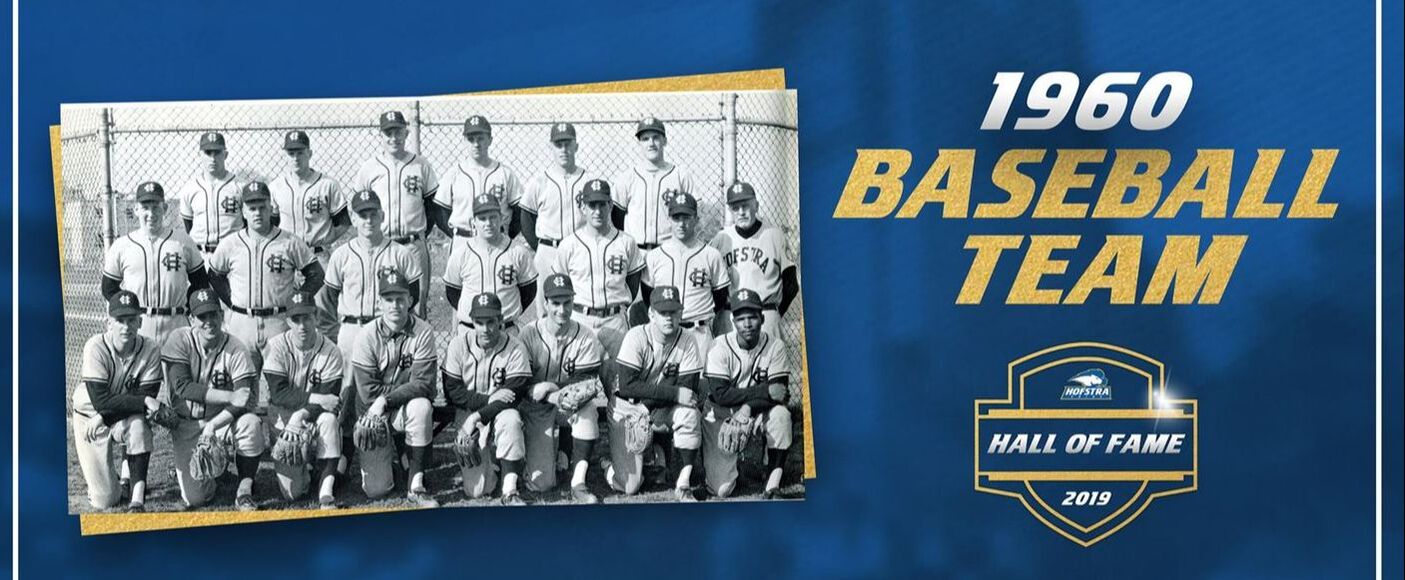 The 1960 Hofstra College baseball team had the best record in school history – 16 victories, 3 losses, winning the league championship. However, the school did not participate in the NCAA regionals that year because of final exams. Because of final exams. That’s what I said. They were my friends and I felt their pain, then and now. You know what old Brooklyn Dodger fans (like me) used to say every fall? Wait til next year! For Hofstra, this was Next Year. But the athletic department somehow could not arrange for the players to take their exams and play in the regionals, something schools do regularly in these electronic days. Stuart Rabinowitz, the current president of Hofstra University, told the audience that if he had been president back then, he would have fired somebody. On Monday night, the school did right by the baseball team. Eight old players were present as the team was inducted into the Hofstra Athletic Hall of Fame. The bureaucratic bungling, 59 years ago, capped off a year of frustration for our great sports teams. The football team went 9-0 but was not invited to a bowl game. The basketball team went 23-1 but was not invited to a tournament. These players won the Met Conference, a great league of local rivals like Manhattan, NYU, Brooklyn, CCNY, Wagner and St. John’s. For three years I was the student publicist, traveling with the team on the silver Campus Coach charters, sitting on the bench in civilian clothes, sometimes yapping at the other team or the umps. Our biggest rivals, our major tormentor, St. John’s, acknowledged this lowly scorekeeper with the taunt: “Shut up, Pencil!” The coach was Jack Smith, who had held the football and basketball programs together during WWII – and was still coaching baseball during our time. The players mimicked his New England accent, his old-timey ways, his expressions like “Son, son, you’re eating yourself out of the league.” But Mr. Smith loved the game. In 1960 I was hired full-time by Newsday and had other assignments that spring. What I missed! This team did not lack for stars. Five players made the Met Conference all-star team:Lefty Dennis D’Oca had a 9-0 record with an earned-run average of 1.84 – one of the best in the country. Ed Burfeindt was a smooth center fielder, known for timely hits. Jerry Rosenthal took a pitch over the eye in 1958 – I saw it, it was horrible -- but he willed himself back into the batter’s box in summer ball and was a graceful shortstop, good enough to later play in the Milwaukee Braves farm system. (I love Jerry’s stories about how he batted for Rico Carty or outhit Lou Brock one week.) George Dempster was the football captain and the star catcher on this team, providing leadership as well as skill. Brant Alyea was a starting forward in basketball and a pitcher and slugging outfielder. The scouts were sitting in their camp chairs behind home plate, taking notes – and Brant would play five years in the major leagues under famous managers Ted Williams, Billy Martin, Dick Williams. Tiny Bill Stetson probably could have made that all-conference starting team, for his stolen bases – 20 in 19 games. Regulars like Jim Sharkey and Dan Gwydir and Arne Moi were often the stars. John Canzanella could pitch and hit. Bill Martin and John Ayres pitched valiantly. Andy Muccillo and Jack Hildebrandt were backups. Another reserve, Tony Major, who became an actor and maker of documentaries, planned to be at the induction Monday but in late May he passed suddenly, and we miss him badly. As Hofstra held its annual induction at a golf course on Long Island, the old players were still sad at the way their season was truncated in 1960, but their lives and careers are testimony to the education they earned.
The president back then was a Shakespearean scholar, John Cranford Adams, not known as a sports fan. While my guys were having their great college careers, Dr. Adams also attracted Francis Ford Coppola, Lainie Kazan, Susan Sullivan and Madeline Kahn to the stage -- and the classroom. A lot of my guys sat out games, or semesters, or even seasons, because of grades or discipline. These people had to be student-athletes in the real sense. My pals, old basketball and baseball players (and one scorekeeper) who meet for lunch occasionally, still feel close to Hofstra because of the friendship of basketball coach Joe Mihalich and baseball coach John Russo (who put up with our ancient tales of "Butch" and "Smitty.") We could not miss the high level of the other inductees Monday – several loyal members of the athletic department, as well as three thoughtful and charismatic stars: Trevor Dimmie, a powerful running back before football was dropped, now a teacher and a minister in Westchester; Sue Weber Alber, three-time defensive soccer player of the year in her conference; and Shellane Ogoshi, a tiny and dynamic volleyball setter who sported the leis of her native Hawaii. The prepared video introductions demonstrated their leadership, their moves. There were no women’s sports at Hofstra in our time; we missed something by not having the company of such proud and accomplished competitors. The final inductee was Jay Wright, who has won two NCAA titles at Villanova since moving from Hofstra. Wright greeted his school friends, his old Rockville Centre neighbors, brought along a contingent of Villanova folks, and talked lovingly about his days at Hofstra. He draws people together. My pals have been hurting ever since that bittersweet spring of 1960. On Monday evening they heard the applause of hundreds of supporters. No NCAA tournament? They won. They won. 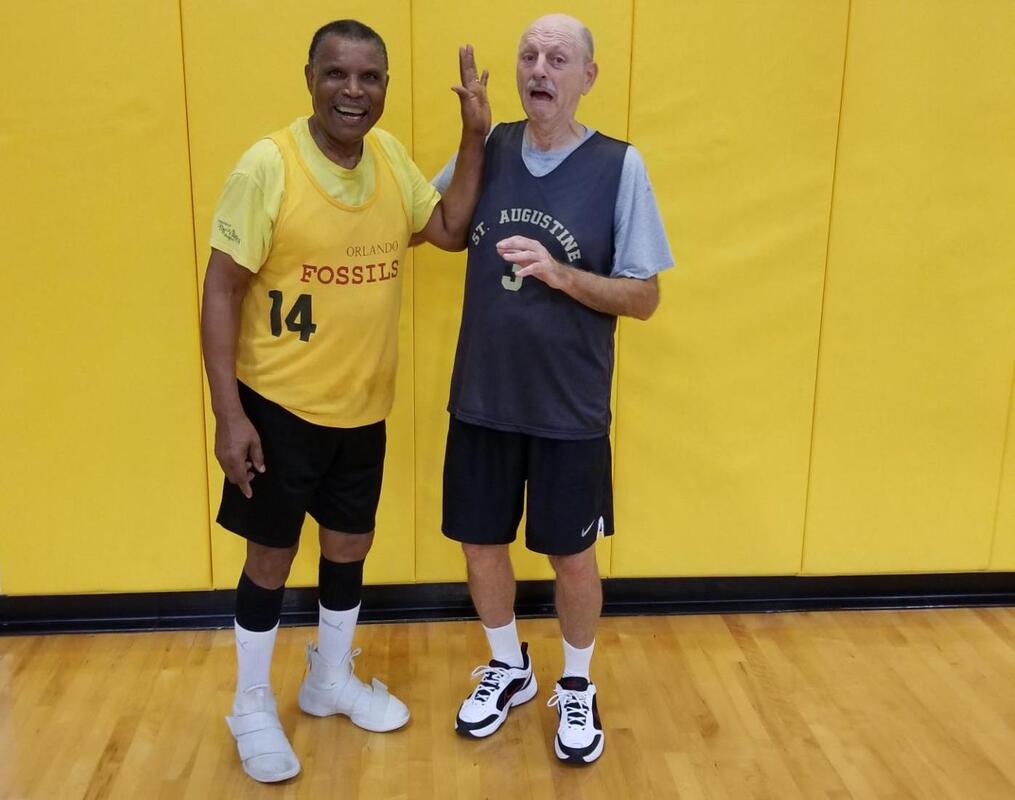 Tony and Sid: Just Like the Old Days Tony and Sid: Just Like the Old Days Only a few months ago, Tony Major was playing 3-on-3 basketball in an over-75 tournament. He could get off his feet, could pop jump shots from the corner. Sent videos back north so his friends could see. He was an athlete and an actor and now a teacher and documentarian at the University of Central Florida, working on a film about Trayvon Martin. He was looking forward to June 17, when he would rejoin some old baseball teammates from Hofstra, when their 1960 team will be inaugurated into the school’s athletic Hall of Fame. Instead, Tony passed suddenly on May 27, at 79. We just heard about it, and a lot of us who knew him back in the day are gutted by this news. Tony made a quickie visit to campus last October, after half a century. He spent part of the day with old jock friends, another part getting a tour of the new communications building from two nice officials and also visiting the playhouse where he had learned to speak Shakespearean. We were all invigorated by his youthful presence. At lunch, he told us about his life. We knew him as somebody who played three sports, but he felt Hofstra was not ready for a black quarterback and he was not big enough to star in basketball. He was a useful member of the 1960 baseball team that won the grand old Met Conference but could not play in the NCAA tournament because of exams. A son of Florida, he had commuted every day to Long Island from Harlem where his mother now lived. He told us about how he gravitated to the great drama department, had tried out for roles in the annual Shakespeare Festival. Laughing at the memory, he described how a black man from the South had learned to shape his speech into the cadence and pronunciations of Shakespearean English. But he did it. And he kept acting, in the city at first. Later, he graduated from New York University Tisch School of The Arts and also taught film production and producing at NYU for two semesters. His baseball ability and knowledge got him a minor role as the backup catcher in the 1973 movie “Bang the Drum Slowly.” He saw young Robert De Niro playing a dying catcher, crouching behind the batter, extending his hands too far. Tony told us how he had passed along some tips about not getting fingers broken by the bat or a foul tip. He moved to Hollywood, playing some bit parts, but also learning about television production. One year he worked with the Dolly Parton show – and raved to me about her intelligence and kindness. And then he moved to Florida, where the university was expanding in Orlando. He began making documentaries, often with an African-American theme. He married late, a woman from Africa, and they had two children, both still in school. “That’s why I’m still working,” he said, laughing. He had so much going on, and now he was reconnecting with some old teammates, plus me, a student publicist who sometimes traveled with the baseball team. Tony had a gentle soul, did not hide the sting of stereotypes. He felt he was used as a pinch-runner in baseball when he could have played more. He recalled road trips to the Mason-Dixon Line, circa 1960, when black players were restricted in the team hotel. And after that, he created a joyous persona, a productive life and career. Early this year, Tony sent me some photos and videos of the over-75 basketball tournament in Florida. There he was, off his feet, getting a rebound, putting it back in. And there he was guarding Sid Holtzer, a former Hofstra basketball player, also still in good shape. In one staged photo, Tony was waving his hand in Sid’s face. Sid never liked that, Tony said. Still didn’t. He giggled at his own mischief. We were looking forward to his next trip north, on the 17th. Instead, there was a funeral on June 8 in Orlando. If there is any lesson to this, it is: reconnect with old friends sooner, and treasure them. * * * Note: Sid Holtzer, another athlete and friend from Hofstra, attended the service and thoughtfully sent photos from the program. (From the University of Central Florida:) https://www.ucf.edu/news/longtime-professor-tony-major-remembered-for-contribution-to-film-ucf/ http://www.nicholsonstudentmedia.com/news/he-brought-hollywood-and-filmmaking-to-orlando-and-ucf-faculty/article_762c9ad0-86c1-11e9-9af6-9b3c9e59c4c9.html One of the joys of being old is the occasional discovery of something lovely, something you never knew existed. That’s what happened Sunday when we saw the filmed performance of Shakespeare’s “The Winter’s Tale” -- not in London but in Kew Gardens, Queens. I am embarrassed to admit I never knew the play, after four years of being around the wonderful Shakespeare Festival at Hofstra College in the late ‘50’s. That was the biggest thing on our little campus, because the president, John Cranford Adams, was a noted Shakespeare scholar, and had made sure we had a Globe Theatre in the new playhouse (soon deservedly named for him). I can still see friends in costume, wielding swords, wooing, declaiming. (Francis Coppola was backstage, learning his craft.) However, in five decades of seeking out Shakespeare all over London, I still had to verify that the “The Winter’s Tale” was his, when it popped up Sunday at the deus-ex-machina art-film house in a funky corner in Queens that reminds me of some blessedly static part of London. Yes, it was Shakespeare. My wife had seen a version at the pit at the Barbican. The plot was for me to discover. Branagh was excellent as the jealous king who touches off the tragedy but the star was Judi Dench as the wise elder who speaks truth to the king. She is 80; her voice and psychic power could cut and polish a diamond. The elders in the movie house seemed to love Dench. They spoke English and Russian and other languages of our city; the lady next to me was Jamaican. No plot giveaways here. I will only say that I remember tearing up near the end of Stoppard’s “Arcadia” a few decades back when the tectonic plates of two separate centuries, two sets of people at a country estate, gracefully overlap. I wish I could say, “Don’t miss this,” but this was essentially a one-off item that may pop up elsewhere at the rare theaters that provide quality films. (The movies in my town are mostly banal trash.) To find quality performances, one has to monitor the schedules for the Metropolitan Opera, the National Theatre Live, the Bolshoi Ballet, and now Branagh’s enterprise in the gorgeously renovated Garrick Theatre at Charing Cross. (My London rellies saw a sold-out “The Winter’s Tale” on Christmas Eve and reported that rare British happening, a standing ovation.) I didn’t stand in the movie house in deepest Queens on Sunday – too busy wiping away a few tears before the house lights came back on. 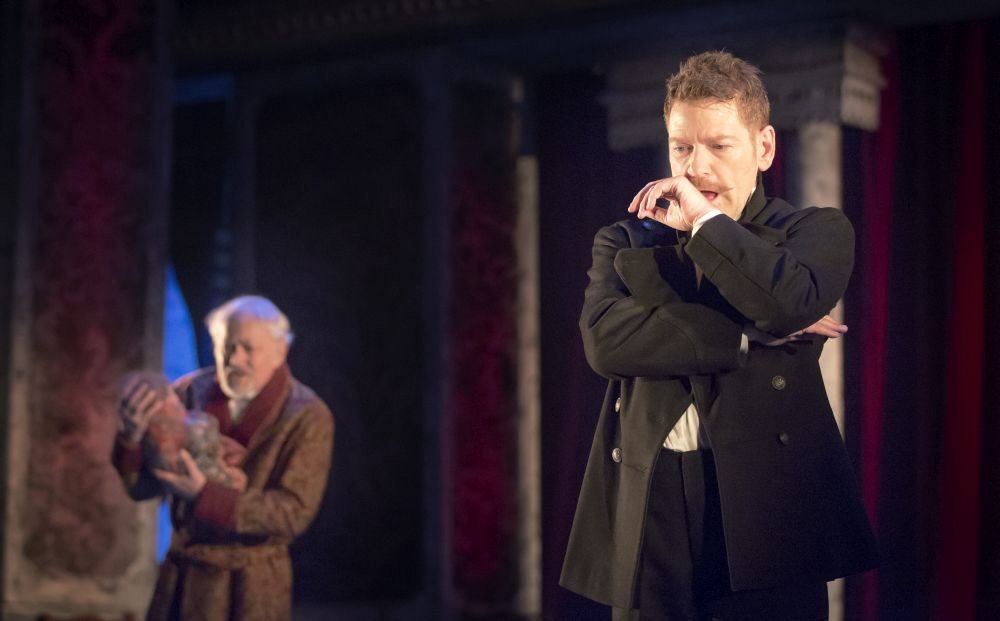 Kenneth Branagh/ Photo by Johan Persson Kenneth Branagh/ Photo by Johan Persson (Sam Toperoff lives in the Alps with his family. He played basketball at Hofstra and later taught there and has had an admirable career writing books and documentaries before retiring in France. The Tour de France has been in their region in recent days; I suggested he send his impressions.
(At first, Sam was going to write from the largest town, Gap, but then he wrote why that was not possible: (“Local shepherds will be staging a manifestation – protest -- because the government is protecting wolves, which they claim are attacking their flocks. Italy, just across the mountains, doesn't have a wolf problem because the shepherds sleep with their flocks; French shepherds do not. Still, the local shepherds plan to disrupt the Tour by loosing 3,000 sheep when the cyclists approach Gap. Seriously. I'm not making this up; this is France, and I love it.” (Instead, Sam waited until Thursday, and he wrote these words and his daughter Olivia took some photos.) By Sam Toperoff Good evening Mr. and Mrs. North America and all the ships at sea, let's go to press. (It's an opening that takes me back to my childhood and so does riding a bike around Laurelton, Queens, when I was about nine or ten.) I always thought bikes were for kids. Not in Europe they ain't! I've never been as taken with the Tour de France, the best bike-riding ever, since I watched the great Bernard Hinault bike past me to victory forty years ago on an uphill climb I could barely manage while walking. I had found myself in the French Alps par hazard and since there were no basketballs around and no one to hit fungoes to, I had to start biking. Frankly, it was the most demanding physical activity I'd ever engaged in. I biked these hills in summer until I was seventy. I actually put the bike away on my birthday after I came up two hairpin turns from a road below my house and barely made it. The other day, to win the 18th stage of this year's Tour, Romain Bardet went up scores of hairpins and scaled the Alps themselves during a 170-km. race while being chased by 170 other world class riders. These are remarkable athletes indeed because of the physical and mental demands they face daily over three-week period. All in all, the race is over 2,000 miles. Bardet is a young Frenchman, and a Frenchy winning even a stage has become a rarity these days; no one from Gaul has won the Tour since the above-mentioned Hinault, who did it thirty years ago! And so tonight, French television is nothing but Bardet, Bardet, Bardet. Of course, it's hard to watch the Tour without wondering how these men can do what they do, especially when it comes to their need to recover overnight after such enormous effort. Even though all of Lance Armstrong's victories have been vacated because of his now-admitted use of illegal stimulants, it is hard to watch such remarkable performances and not remain somewhat cynical. The Director of the Sky Team, for whom Christopher Froome rides, the Englishman Sir David Brailsford, is on television almost daily assuring viewers (his French is perfect) that his team is clean. "I don't blame people for being cynical," he said the other day, "but other than the unlimited testing of my team and giving the public my word, what can I do?" The shadow of Lance Armstrong still shades the Tour. I despise him for what he did. Worse, he put doubt in my appreciation of what I am witnessing; cynicism's worst effect is that it robs one of pleasure. And poor Chris Froome -- a truly great rider -- and young Romain Bardet -- and my particular favorite Alberto Contador -- they all become objects of suspicion. Nevertheless, I'll be in front of my set for tomorrow's stage.” Merci, Sam. He was born April 23, 1564, this much we seem to know.
Whoever he was, he is our patrimony, the synthesist of the English language, creator not just of Lady Macbeth and Falstaff but of Emma Thompson and Monty Python, Margaret Thatcher and Boris Johnson. He saw it all coming. I was introduced to Shakespeare in the late winter of 1956-57, the tail end of the basketball season, when I was the student publicist at Hofstra College. The gym was commandeered by a new cast of characters. Instead of housing Butch Van Breda Kolff and his motley band, the gym now held Shakespeare and his rollicking crew. The annual Shakespeare Festival forced gym classes outdoors or into the Quonset Hut, and caused Butch’s basketball team to finish on the road. Workers began to assemble what looked like a mix between a Lincoln Log and Tinker Toy construction. Beams and pillars and floors and balconies were lugged into the gym, and put together like a giant puzzle. The Globe Theatre was the pride of President John Cranford Adams, a Shakespearean scholar, a trim older man with a vaguely British accent and wardrobe somewhat out of place in this informal suburban world. (The next year the festival moved into the new John Cranford Adams Playhouse, still the secular temple of my alma mater and soon to be refurbished, thanks to a benefactor.g) One of the 1957 stagehands was a fellow freshman – Franny, he was called, in those days, not Francis Ford Coppola. He was a legend for not wearing the ratty gym outfit or olive-green ROTC outfit (years later he told me he had polio as a child and was excused from both.) Instead he wore a workman’s overalls, baggy, with pockets containing hammer, screwdriver and other implements of construction, preparing not just the featured play, “As You Like It,” but also odd little morality plays and musical concerts. One afternoon I watched a performance, as students I had seen on campus wore gaudy ruffles and low-cut gowns, speaking a language so easy to parody, indecipherable at first but as the ear became accustomed to the cadence, perfectly clear, the wit, the drama, the poetry. I cannot claim I loved it, had some kind of metamorphosis, but this was as good a reason as any to attend a college heavy on the liberal arts. Out of nowhere, William Shakespeare became my boot camp for language, my basic training for the mind. Shakespeare has lasted this long, as I follow the academic debates about his journey from Stratford to the South Bank to everywhere in the world. In my years covering Wimbledon – all right, now I will admit it – I would sometimes find a way to join my wife at the National Theatre or the dismal claustrophobia-inducing Barbican. And one wet June evening in 1997, after I had typed fast at Wimbledon, we bought groundling tickets and stood in the solstice downpour at the new Globe Theatre, watching Henry’s troops heading into battle, and we understood our job was to hiss and whistle at the French soldiers, and maybe toss the odd packet of crisps at them. Years ago, we wandered into the National Portrait Gallery and spied a man with an earring smirking out at the world. It is the so-called Chandos Portrait (for a previous owner) and the artist may have been John Taylor. The subject is said to be young Will Shakespeare, down from Stratford, to write and drink with his buddies and snag as many women as possible. I take the young man to be Shakespeare because his leer matches the knowing lilt of the plays and sonnets. Whoever and whatever he was, he doth endure. Happy Birthday, Dude. Bill Nighy was the main reason I watched the PBS drama “Turks & Caicos” on Sunday night, about a British spy on the run. Nighy is so cool; I want to be him when I grow up.
But Nighy was not the revelation of this movie. In the second hour, a new character came sashaying right down the middle -- 4 feet, 1 inch, but 8 feet tall in attitude. Meredith Eaton – I never heard of her – was playing a highly capable character with a purpose. No sense ruining the plot if you catch up with it, and you should. She kept right up with actors like Nighy, Christopher Walken, Winona Ryder, Helena Bonham Carter and, oh yes, Ralph Fiennes. Because PBS and other stations have the annoying habit of running the credits at warp speed, I did not catch Eaton's name in the blur. How rude to actors. But I looked it up on the web, and Wiki had a full credit list, with links. I should have known from the Lawn Guyland accent: Eaton went to my alma mater, Hofstra University, majored in psych, minored in drama. She recently turned 40, and was the first female dwarf ever to have a major recurring role on an American TV drama (Family Law, 1999.) Hofstra has sent bombshells into the world before. Lainie Kazan (then Lainie Levine) was a classmate in the late ‘50’s, steaming up the new John Cranford Adams playhouse in “Pajama Game.” And a few years later, it was worth going back on campus to catch Madeline Kahn, long before she played Lili Von Shtupp in “Blazing Saddles.” In fact, there are Hofstra connections to three of the four people in the photo above. Christopher Walken was a dancer who went to Hofstra for one year before learning how to talk funny. I don’t believe Bill Nighy has any Hofstra connection. And Winona Ryder, so edgy in “Turks & Caicos,” has a Hofstra link in this way: about a decade ago I visited Francis Ford Coppola, another classmate, at his home in Napa. In his studio was a chair with the name Winona printed on it. Sit in it, Coppola motioned. So I did. He had directed her in “Dracula.” I’m counting it as a Hofstra connection. Now Hofstra has done it again, another actress who lights it up. Meredith Eaton is not in the final part of the trilogy, "Salting the Battlefield," next Sunday on PBS, but she needs to be in something else, and soon. Somebody asked me what I think of the schism in the N.C.A.A. and I replied, “Not much.”
Frankly, big-time college sports lost me years ago. I had to cover it, moralize about it, until I stopped writing a regular column for the Times. At that point, I didn’t have to write, or watch, or think. So much else to do in life. From what I read of Thursday’s developments, the breakup of the N.C.A.A. is the logical extension of what I have been witnessing for decades. I saw major universities bolt from traditional, regional rivalries in established conferences to pursue more television money. It’s all about the networks – and why should they care? If they have programming, that is their mission. Education was supposed to be the mission of colleges, even the ones that are spinning off into a dog-in-the-manger Big Five. But I have never heard a valid argument linking education and big-time sports. The closest presidents and other apologists could come up with was that it got wealthy boosters on campus in September. Possibly, some athletes in the new elite group will get paid more, have better health care, as they prepare for a professional career that few of them will achieve. I can assure you that the demands will be higher, also. What do you mean you have an afternoon lab? Go lift weights. I don’t know what will happen to the leftovers in Division I. I saw my alma mater, Hofstra University, give up football a few years ago because of seven-digit losses every year. I ache for my friends who played football – and got educations – decades ago; their hearts were broken. Nowadays, students wouldn’t walk from their dorms to watch a second-tier football program. They’d rather watch Alabama or USC. on the tube. Maybe more schools will be encouraged to give up football, to back off rogue basketball programs. The way I see it, the University of Chicago and New York University are doing fine since they took a big step back from professionalism. My athlete friends got educations while playing sports at Hofstra back in the late 50’s and 60’s. I am in touch with some – a few teachers and entrepreneurs, a poet, a writer, a dentist, a few television executives, a major-league ball player. They had teachers who would flunk them if they didn’t do the work. I don’t believe that is the remotely the case at big-time schools. I am always stunned when I hear that somebody got a degree while playing football or basketball, and I am impressed when an athlete shows signs of having opened his eyes and ears on a college campus. It’s been heading that way for decades. The N.C.A.A. has been found out – not as universally sordid as FIFA, the world soccer body, but hypocritical on a domestic level. I was creeped out listening to the newest president, Mark Emmert, on his visit to the Times a few years ago: he was obviously a front man for networks and boosters. One nice thing about retirement is that I can ignore college football and basketball. My sports more or less rotate from baseball in the warm months to soccer in the winter. More than enough. It is nice not to care. That's what I think. Every name has a story, and our daughter Corinna tells hers in a lovely May Day essay today.
http://www.wilson500.com/uncategorized/my-name-day-and-the-value-of-a-good-affordable-education/ She tells the story on the day when she witnessed her friend Jacky Nkubito become an American citizen in DC. The name happened as Corinna tells it. I was taking a course on the Cavalier Poets with Dr. Ruth Stauffer at Hofstra College in the spring of 1960, the last semester of my very good liberal arts education. I loved the urgency of Andrew Marvell: Had we but world enough, and time, This coyness, lady, were no crime. It’s possible I might even have used those words, or at least felt the sentiment, in that beautiful flowering spring. I also loved the poem Corinna’s Going a-Maying by Robert Herrick, which our daughter describes so nicely. So how did we name our two other children? Marianne and I agree that her mom, still with us at 93, loved the name Laura. Also, Marianne and I both knew the David Raksin song “Laura,” from the noir movie of the same name, from 1944. Laura is the face in the misty light Footsteps that you hear down the hall The laugh that floats on a summer night That you can never quite recall. One version is by Frank Sinatra -- long before his ring-a-ding-ding stage, I hasten to add. It's a little lush, but a time piece. https://www.youtube.com/watch?v=7uXPeBRt1fM I was sold as soon as the name Laura was proposed for our oldest daughter. And she’s not the only Laura named for the song. In the comments portion of the youtube Sinatra version, LauraLaVitaEBella says her grandfather gave her the name. Bravo, Nonno. How did we arrive at David for our third child? Marianne notes that I wanted to name him Dylan. It would have been perfect. She counter-proposed David – for the Michelangelo statue in Florence. Many years later, I came to understand King David through the Leonard Cohen song, written in 1984, now one of the great touchstones of contemporary life. http://www.theatlantic.com/entertainment/archive/2012/12/how-leonard-cohens-hallelujah-became-everybodys-hallelujah/265900/ Personally, I am partial to the k.d. lang version on her glorious Canadian tribute, Hymns of the 49th Parallel. https://www.youtube.com/watch?v=f0UHv7mDG4s So I say, Hallelujah for music and poetry and art. Hallelujah for May Day. And Hallelujah for Citizen Jacky in DC today. One thing I noticed at the conference at Hofstra University the past three days: the coming World Cup in Brazil is going to provide the biggest spotlight ever pointed at the soccer establishment.
Between the rampant scandals at FIFA and the protests in Brazil, the world is going to be watching in a different way than at all previous World Cups. Now the journalists and academics and fans are asking, is this the right way to run a sport? Does soccer need to impose such harsh demands about expensive stadiums and infrastructure on people who have been told they really need this party? There were already demonstrations in Brazil in 2013, and the favelas, the neighborhoods have been further disrupted for a six-week frolic for outsiders. That conflict seemed to be the common theme among the mix of former professional players, journalists, academics and fans who mixed in esoteric panels. This really is the world’s sport. Yet it has gone ever further into the control of the corporations and networks and the murky home office of FIFA, the world soccer body. Maybe the most telling sign was raised by David Goldblatt from the University of Bristol, U.K., who noted that the organizers in Brazil are banning musical instruments in the stands. (He’s a fan of the South African vuvuzela that terrorized eardrums in 2010.) Imagine a soccer game in the land of Jobim and de Moraes, Veloso and Gilberto, Gil and Costa, Ana & Jorge and Morelenbaum2Sakomoto, without a few drums and horns and guitars? But FIFA is tone deaf as well as opaque. The restive state of Brazil was noted by Peter Alegi of Michigan State University, who recalled how home fans spontaneously sang the second stanza of the national anthem during the Confederations Cup – a sign of further independence, perhaps. Every panel reminded me of the deep hold this sport has everywhere, including my alma mater of Hofstra, where the new version of the Cosmos is currently playing. Hofstra bestowed an honorary doctorate on Pelé, the greatest of the Cosmos. He lit up the place. He is Pelé. The links between soccer success and national image were stressed by Alexander Kitroeff of Haverford College, who noted how his homeland of Greece was stirred by the surprising victory at the 2004 European championship. Greeks were also aware that the squad had been given shape by a German coach, Otto Rehhagel. One of the nicest parts of the conference was the papers delivered by young people coming along as the United States matures as a soccer nation. Christopher Davis of Florida International University gave a paper on “The New Germans: How the 2010 World Cup Showed the Evolution of Germany’s Immigration Policy” – the Turkish, African and Polish influence on the German squad. And Lisa Quach, about to graduate from Hofstra and looking for a job in publishing, delivered a knowing paper on “Black, Blanc, Bleu: National Identity in French Football,” recalling how players from the vast diaspora of France played together in the glorious home championship of 1998. One of the great spontaneous dialogues between true believers took place during the Q&A section of a panel. In the audience, Arnie Ramirez, the great former coach of Long Island University, said he preferred the short-pass offense; he wiggled his hand like a trout. Greg Lalas, former M.L.S. player and editor of MLSsoccer.com, responded, what about the laser long ball that lands on a striker’s chest near the goal? They debated for a few minutes. It was wonderful. A defiant note was sounded at the final plenary session by Charlie Stillitano, Princeton star, World Cup 1994 official and first general manager of the MetroStars. Charlie said he doesn’t want to hear any more bleats that America is not a soccer country. There are now five major sports in the United States, Charlie said. Get over it. I thank Stanislao Pugliese and Brenda Elsey of Hofstra who ran this conference, and all the other nice people who make Hofstra work. And I thank all the true believers who reminded us that, good and bad, the World Cup is almost here. Before the World Cup arrives in June, I would suggest a refresher course on the world’s sport.
Starting on Thursday, Hofstra University – my alma mater – is holding the academic conference, Soccer As the Beautiful Game: Football’s Artistry, Identity and Politics. It will run for three full days, including an appearance by Pelé on Friday, when he will receive an honorary doctorate. And on Sunday at Hofstra will be a clinic as well as a match by the new version of Pelé’s old team, the Cosmos. I will be on two panels Saturday and on Thursday will moderate a panel about the original Cosmos, still the most famous soccer club in the history of the United States. Right now, like any coach, I am sweating out the formation -- how to play Roger Allaway, the Soccer Hall of Fame historian, David Kilpatrick of Mercy College, Shep Messing, former Cosmos keeper and analyst for Red Bulls matches, and Leo Glickman of the Borough Boys. I will submit my lineup when the officials ask for it. The academics are coming from all over the world. I am hoping they will wear period costumes like the Germans and Greeks of the famous Monty Python skit, but maybe not. More to the point, they will expand our understanding of the sport. I spot one former men’s national player, Chris Armas, now the women’s coach at Adelphi, on a panel on Saturday. And I look forward to seeing – and hearing – friends and colleagues from around the soccer diaspora. For a full glimpse of the program and information about tickets (and some free events): http://www.hofstra.edu/community/culctr/culctr_events_soccer_conf.html I was in awe of Sam Toperoff days into my freshman year at Hofstra College. From my workship with the athletic department, I knew he was a transfer basketball player, out of the service, waiting to play the following season.
Then he turned up in a sociology class, and he stood out. He was 5-6 years older than me and knew how to talk in class. I still remember Professor Nelson explaining the sociological concept of brothers and others – the circles of life, people we care about, people we don’t necessarily care about. “You, Toperoff, are my brother,” Professor Nelson said, “and the rest are others.” A hundred people in this huge lecture hall, and the professor knew Sam’s name. Toperoff started for a couple of seasons of varsity ball. My strongest memory of him is singing – maybe a Belafonte song? – in the locker room before a road game, nervous energy, channeled into song. He was a force. Stephen Dunn, the shooting guard, now a Pulitzer-Prize-winning poet, tells about listening to Sam and another teammate in a hotel room, talking about Moby Dick. Imagine. Not women or zone defenses, but words, concepts. (That was quite a team -- a novelist and a poet, starting.) Sam taught at Hofstra for 20 years and has written 13 books on extremely varied subjects, including the gripping Pilgrim of the Sun and Stars, about a Basque peasant who makes a pilgrimage to the Vatican. Sam also wrote sports for magazines and for 15 years worked for public television, most notably a travelogue series. My wife bought all of them. Now Sam lives in the French Alps (in a house he built) with his wife and daughter and grandson. He is a hero to his pals because he has continued to write. Lillian & Dash, his novel about the long affair between Lillian Hellman and Dashiell Hammett, is being published by Other Press in July of 2013. Sam has gotten good advance attention, including a Kirkus review. The novel is available via Amazon and other sources. I've read it, and I love the dialogue and insight into two talented people from another time and place. It’s been a lot of decades; Toperoff still scores. They are a walking advertisement for that elusive blend of sports and education – starting with a Pulitzer Prize-winning poet, Stephen Dunn, all 12 a credit to themselves and the school. My guys from Hofstra College, circa 1959-60, knew the academic apparatus of that modest commuter school would flunk them right off the team if their grades slipped. The basketball team from that year, which won 23 games and lost only one, is being honored Saturday by induction into the Athletics Hall of Fame. There is a dinner at 4 P.M. followed by a lacrosse game against sixth-ranked North Carolina. That team was coached by Butch van Breda Kolff, the former Knick, who would later coach Bill Bradley at Princeton and bench Wilt Chamberlain in a championship loss with the Lakers. They still hear Butch’s piercing whistle in their nightmares. I was a student publicist on a workship. Saw them up close, kept track of their assists and rebounds, sometimes did the public address, called the results into the papers, and listened to Butch and his assistant Paul Lynner tell great stories at diners, very late at night. That was an education, too. I’ve written a lot about that team over the years: The shot by Bob Larsen of Wagner for the only loss of the season. We caught up with Larsen last year in New York: http://www.nytimes.com/2012/03/01/sports/ncaabasketball/52-years-later-recalling-a-shot-that-sank-a-season.html?_r=0 There was a reunion in 2000, when the players and school got to thank Butch one more time: http://www.nytimes.com/2000/02/06/sports/sports-of-the-times-for-butch-s-players-23-hoop-dreams-and-one-nightmare.html?pagewanted=all&src=pm But the main thing was, the players went to class – even after late bus rides back from Pennsylvania. They knew the team had been decimated a few years earlier because players were not getting the grades. This was a small, serious place, where first-generation college students were getting an education. The president was John Cranford Adams, a Shakespearean scholar whose dream was not the basketball team being invited to the National Invitation Tournament but building a permanent home for the Globe Theatre – now the John Cranford Adams Playhouse, a wonderful place. Francis Ford Coppola produced original plays in that building. He was our classmate. Lainie Kazan sang in the musicals. She was also a classmate. (Did I mention that our football team was 9-0 in 1959? Alas, our aging classmates do not feel part of that any more, since Hofstra abruptly terminated the program in 2009.) Most of the basketball players are coming back on Saturday, some of them with rebuilt hips and knees after all the torque they put on their bodies. (One of them has a reinforced aorta from a recent operation; others are survivors of this and that; thank goodness for modern medicine.) Stevie Balber, the bow-legged point guard from Brooklyn, who gave everybody nicknames, has passed on. In 2000, I wrote, “They took their educations and went about being responsible adults.” I mentioned Adam Gadzinski an accountant; Bob Stowers a teacher; Ted Jackson a parole hearing officer; Stan Einbender an endodontist; Curt Block for many years a vice president for media relations at NBC; Richie Swartz a furniture salesman; Bob Lauster a salesman for I.B.M.; Richard Goldstein, operating the family shoe accessory business; Stevie Balber the chairman of a direct-mail company; John McGowan an engineer; Stephen Dunn, poet and teacher; and Brant Alyea who played 361 games in the majors. I cannot wait to stand at the fringe of these guys I admire so much, and hear the stories – often about Butch. I love Brant’s stories about being managed by Ted Williams and Dick Williams. The players recall how Stowers could do a standing leap from the floor of the gym to the stage at one end of the court; how Swartz could lull you into submission in practice and then flick the ball away with his long arms; how Einbender – the 6-4 captain and leading rebounder -- blew a dunk in the closing minute of his final game and walked straight to the bench, to save Butch the trouble of hauling him off the court for showboating. They could also talk about the modest commuter college that was doing things right. Their lives reflect that. * * * In a totally different time, Hofstra appointed a new coach, Joe Mihalich, on Wednesday. Mihalich, the coach at Niagara for 15 years, replaces Mo Cassara after a turbulent season. Mo put his heart into the school. I wish both of them well. * * * Stephen Dunn wrote a lovely essay about his education from Butch and Hofstra, on a site called sbnation.com but the link does not seem to be working without signing up for the site. http://www.sbnation.com/whiskey-room/2013/4/6/4190298/stephen-dunn-poetry-and-basketball WHAT THE CAPTAIN SAID: (I went to school nine straight years with Stan Einbender, from JHS 157 to Jamaica to Hofstra. We are closer than ever. I enjoyed his remarks on Saturday when Hofstra honored the team, and I enjoy his second thoughts on Sunday. I saw him chatting with a member of the great 81-82 women's team that had such spirit at the dinner. That was one thing we did not enjoy in our time -- visible female athletes. How much richer sports are today with competitors like the women from 81-82. Here are Stanley's remarks GV) AT THE DINNER: Speech for ’59-’60 Team First I would like to thank the committee that gave us this great honor, President Rabinowitz and Athletic director Jeff Hathaway who both seem committed to restoring Hofstra Basketball to the standard that we set. I listened to the news conference on my computer on Wednesday to introduce Coach Michalic and was encouraged that this was a good first step to reaching that standard. I was the only senior on the team, and I assume that was the reason I was asked to say a few words. I know that some of the other players might be more articulate, such as Steve “Radar” Dunn, a Pulitzer Prize winning poet, or even my longtime friend George Vessey who was not a member of the team, but has written many articles about our team in the NY Times. I was eager to take up this task because of the fond memories I hold for this team and our accomplishments, and my gratitude to Hofstra University for giving me the opportunity to compete and get a great education which led to my career as a dentist for 40 yrs. It is very apropos that we be inducted into the Hofstra Athletic Hall of Fame as a team, because we were the best example of a team. There was no superstar on our team. I believe we had at least five players that averaged double figures. Under the guidance of Coach Butch VanBreda Koff and Ass’t Coach Paul Lynner, we were not interested in who shot or who scored, but only leaving all we had on the court and winning. As our 23-1 record showed, we did a pretty good job. A successful basketball coach is depends on his recruiting and being able to get his role players to accept their job. Butch had an easy time with the ’59-’60 Team, because we were all role players. Some players today do not realize what a privilege it is to compete in any inter-scholastic sport, especially at a great school like Hofstra University where we could also receive a great education. In closing, I would like to mention a conversation I had with Coach Van Breda koff. After leaving Hofstra for the second time, he would return for certain basketball functions. It was very annoying that we seemed to age and loose some hair, and the Coach seemed to stay the same with that boisterous voice. The last time I saw him he looked quite frail. He was suffering from the Parkinson’s Disease that took his life, but he was alert enough say to me, “Stanley, these players today are better athletes, but you guys were better basketball players”. That meant a lot to me then and I am sure it does to all the members of the ’59-’60 Team. It still means a lot to I stand here now. EINBENDER'S THOUGHTS ON SUNDAY Last night, I, along with my teammates from the ’59-60 Hofstra basketball team, received the long awaited recognition by being inducted as a team into the Hofstra University Athletic Hall of Fame. Our record of 23-1 stands as the best record ever established by a Hofstra men’s basketball team. As expected, the University put on a great show with lengthy introductions, a great meal, and most important, the recognition of our accomplishments. I was given the honor of speaking for our team, which gave me a chance to thank Hofstra for the great memories that I still hold. The best part of the evening was the ability to renew old friendships with my teammates, many who I have not seen for over 50 years. When I am not looking in the mirror, I still see myself as that smiling person holding the basketball in the ’59-’60 team picture. After seeing my teammates from that team, I realize that our time as basketball players has passed, but at least we definitely had our time. I hope these renewed friendships will continue and we can all keep seeing ourselves as we were in that picture. I believe that those memories will help us to survive in fleeting years that remain. Rusty Staub, Bud Harrelson, Ed Kranepool, Art Shamsky, Ed Charles, Skip Lockwood and Joan Hodges -- just to drop a few names.
A lot of early Mets history will be coming to Hofstra University on Long Island Thursday, Friday and Saturday. Then there are the writers (Stan Isaacs and Steve Jacobson) and broadcasters (Sal Marciano) and historians (John Thorn) among panel members, commemorating the 50th anniversary of the Amazing Mets in a conference that figures to be both academic and fun. I'll be moderating two panels at Hofstra, my alma mater, Friday afternoon. In the spring of 1962, I was taking my one and, as it turned out, my only graduate course -- the novel, with a terrific three-week segment by Dr. Hull on Ulysses, about a very human being who spends a long day wandering but finally gets to go home. How fitting. . In sleet and rain, on Friday, April 13, also fitting, I attended the Mets' first home game – as a fan -- at the Polo Grounds, along with my Newsday pal George Usher. By mid-season I was one of Casey Stengel’s “my writers,” standing by his side at his 72nd birthday party in St. Louis, when he most emphatically did not ask, “Can’t anybody here play this game?” Never signed up for any more grad courses. Dr. Hull and Casey. Both great teachers. With my three grad credits, I get to run two panels Friday afternoon at the Hofstra conference. At 3:15 PM, I will introduce my long-time friend, Ed Charles, the heart and soul of the 1969 Mets, who promises to recite a new poem for the anniversary. And at 4:15 PM, I will conduct a panel entitled: New Yorkers Recall the Dark Ages: Four Long Years Before the Birth of the Mets. Panel members will include Joan Lombardi Hodges, Gil Hodges, Jr., Stan Isaacs, the landmark Newsday columnist known for his appropriately-named column Out of Left Field, and Marty Adler, head of the Brooklyn Dodgers Hall of Fame. Although a proud son of Brooklyn, Stan Isaacs promises to stick up for his dearly departed New York Giants. We will be talking about the four lean years without the National League in New York,and then the bizarre early years of the Amazing Mets. For information: http://www.hofstra.edu/community/culctr/culctr_events_mets.html |
Categories
All
|
